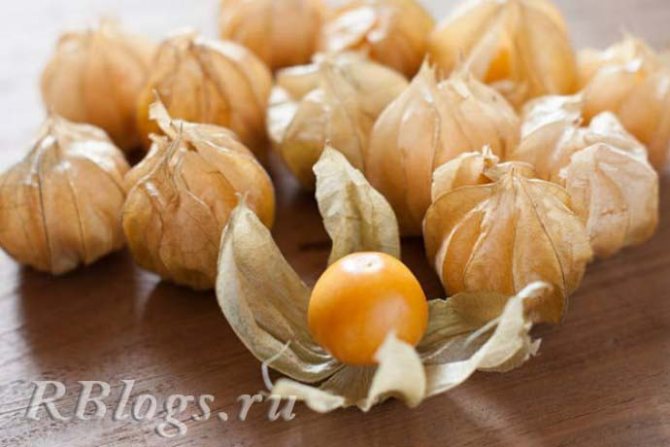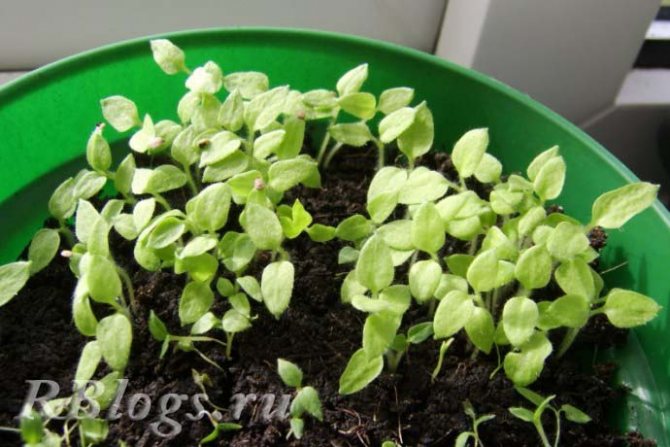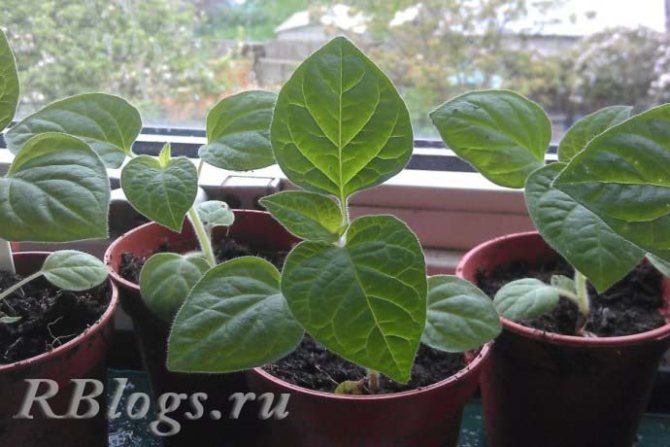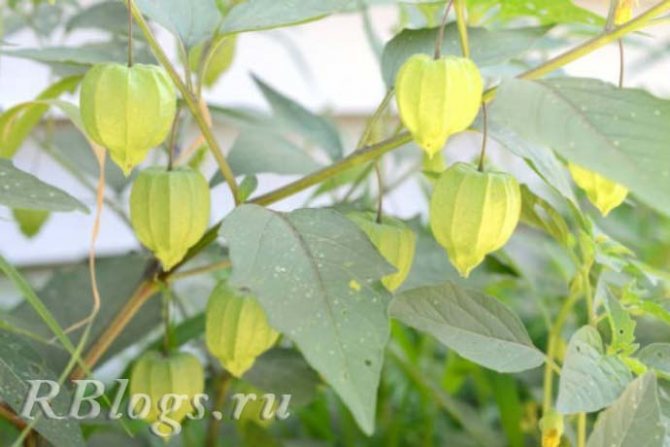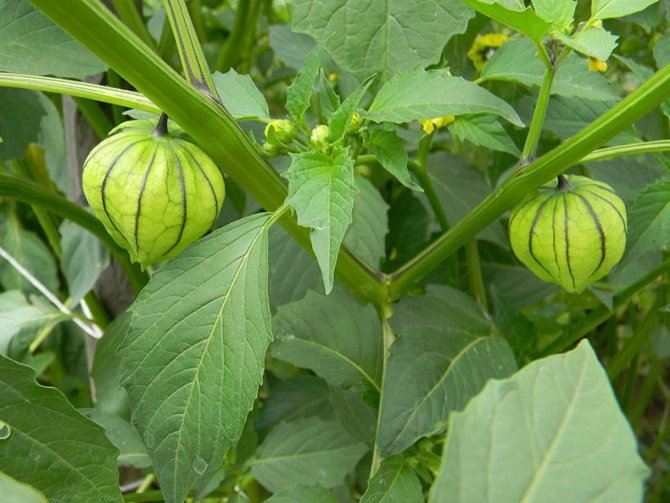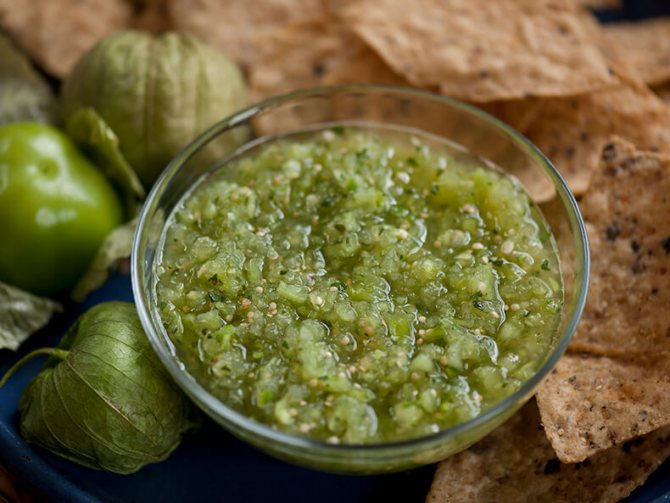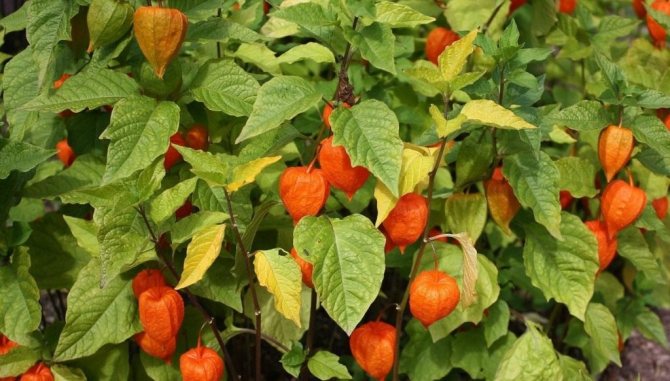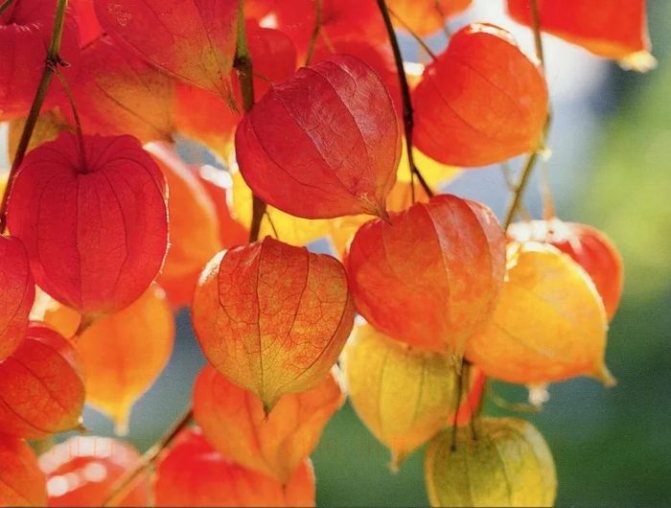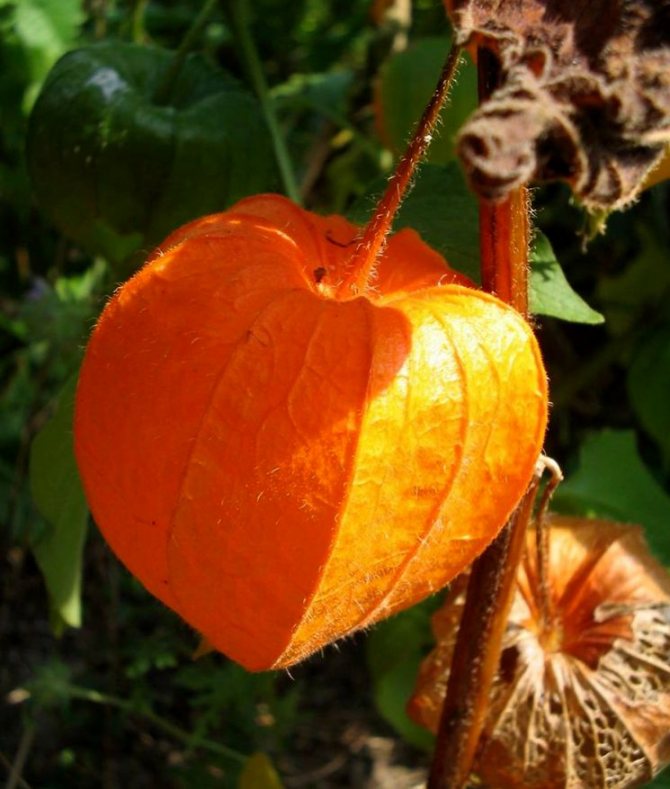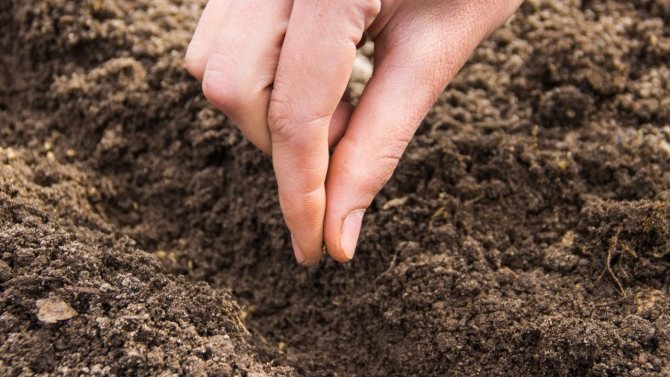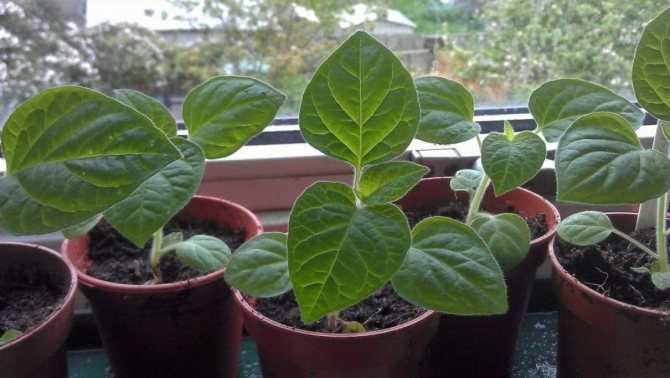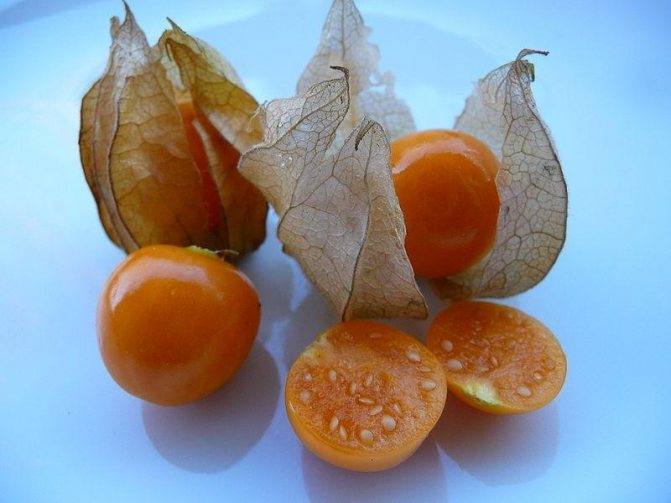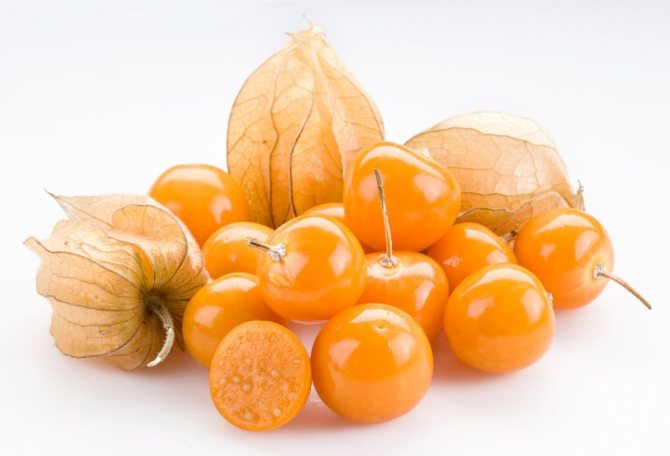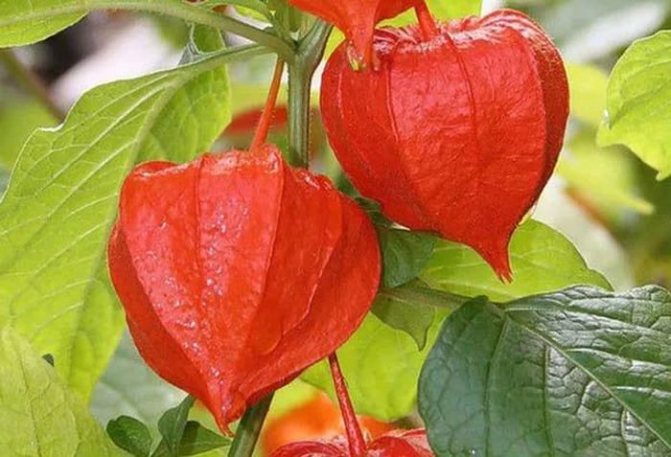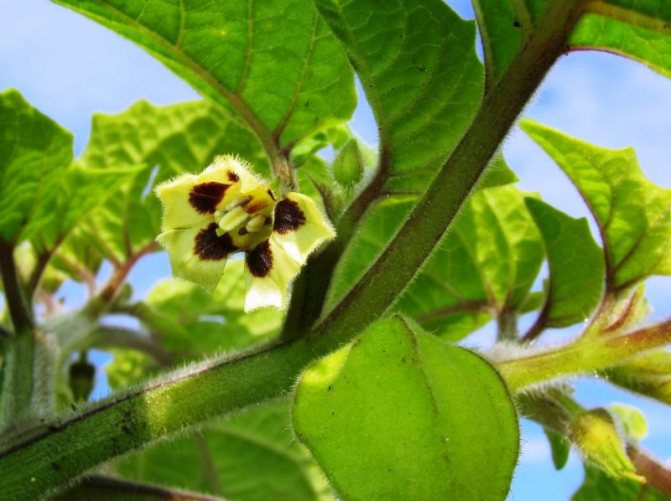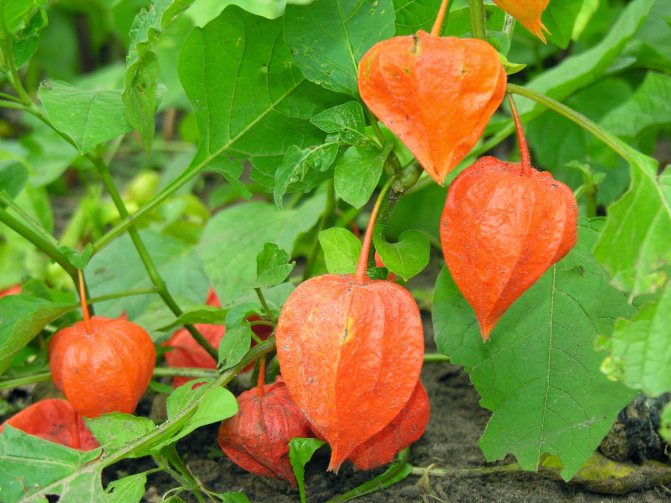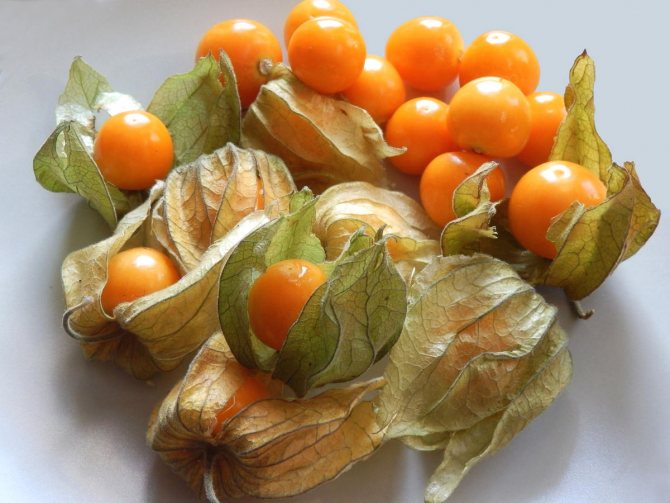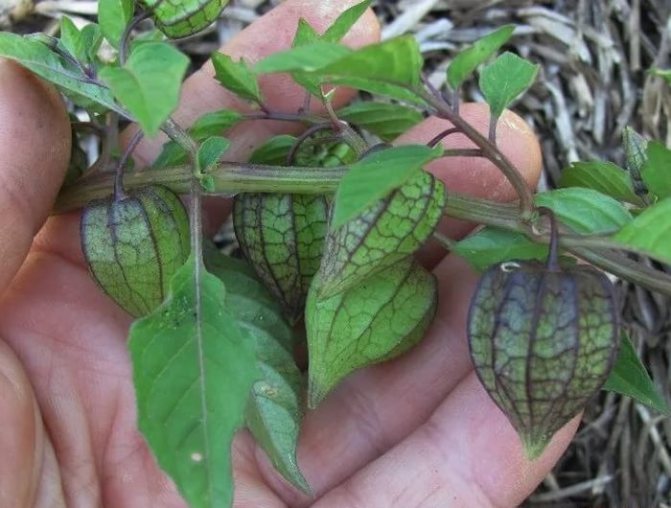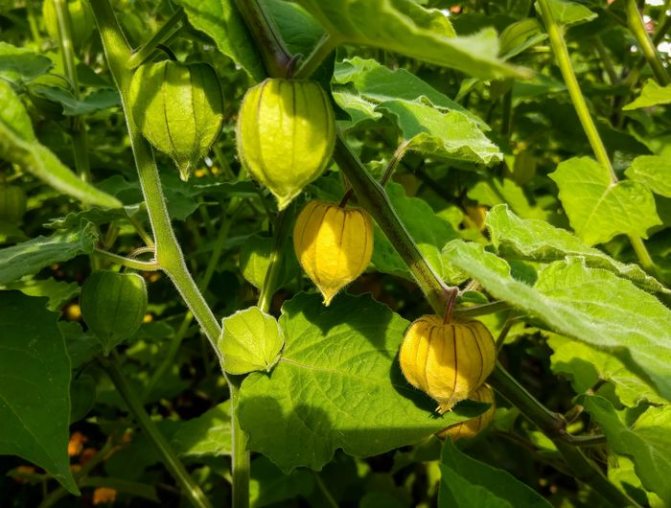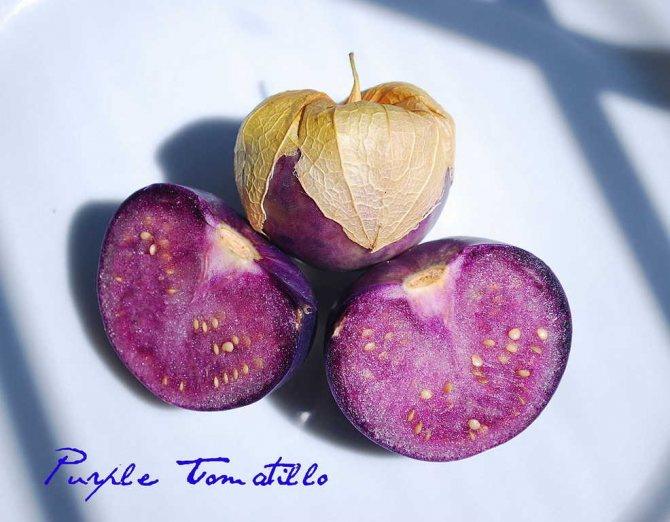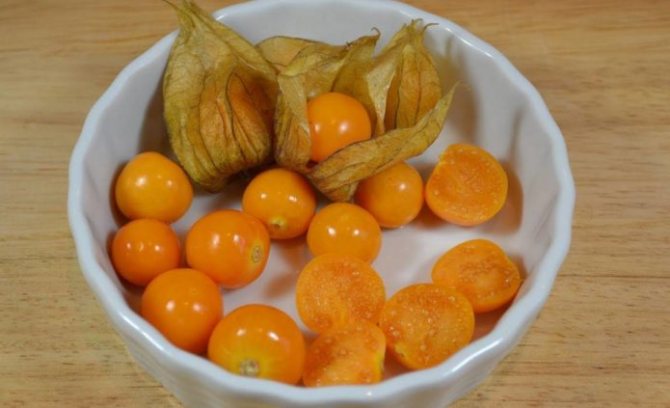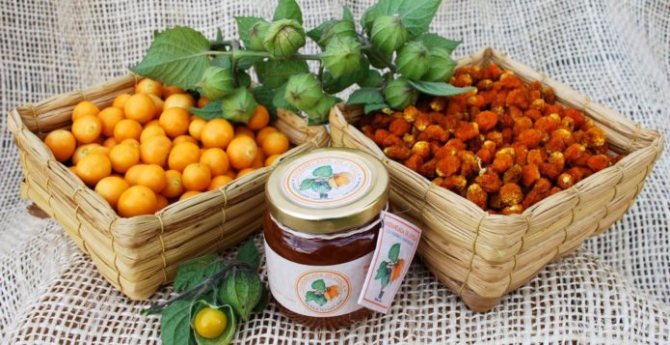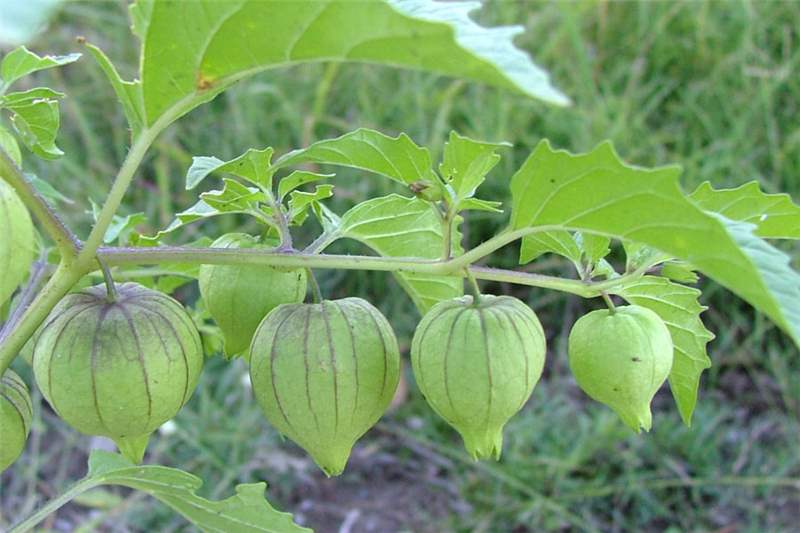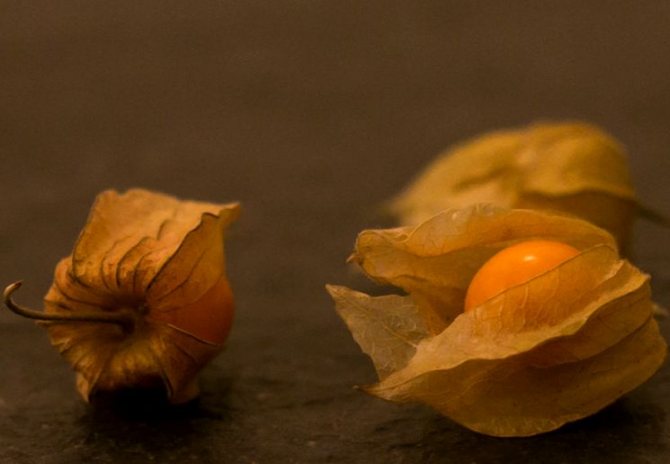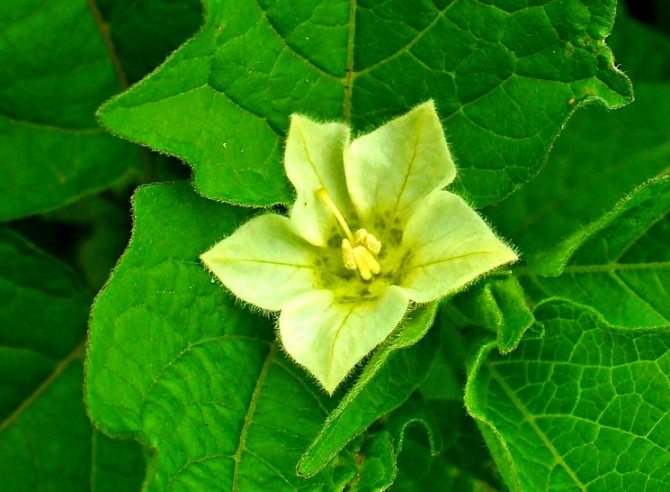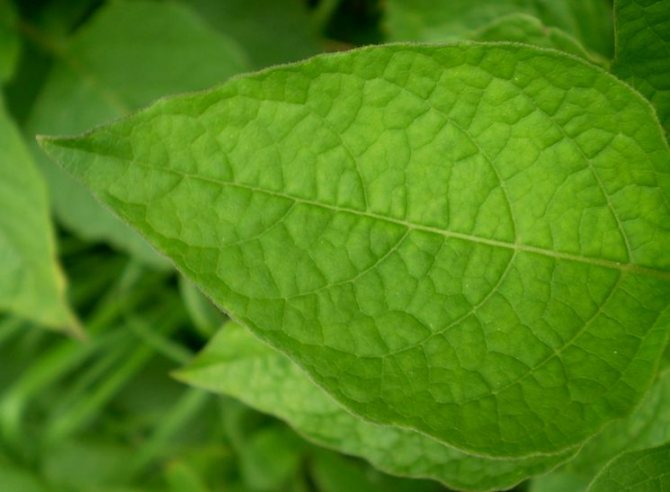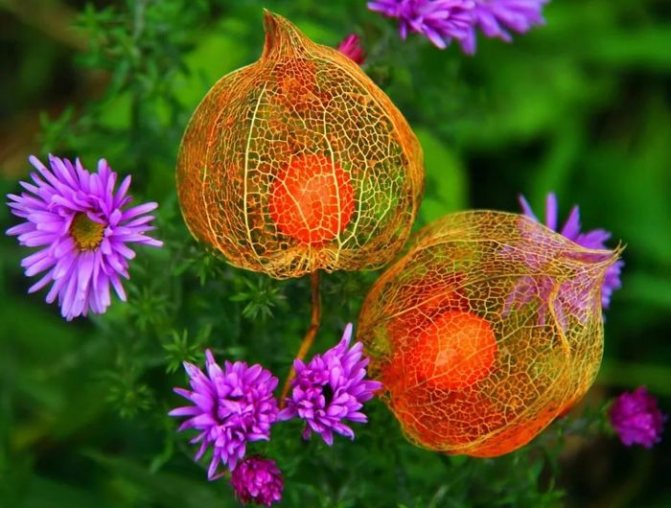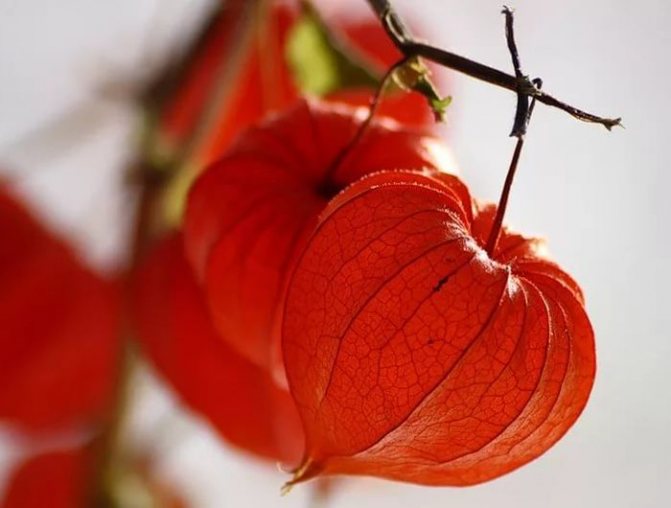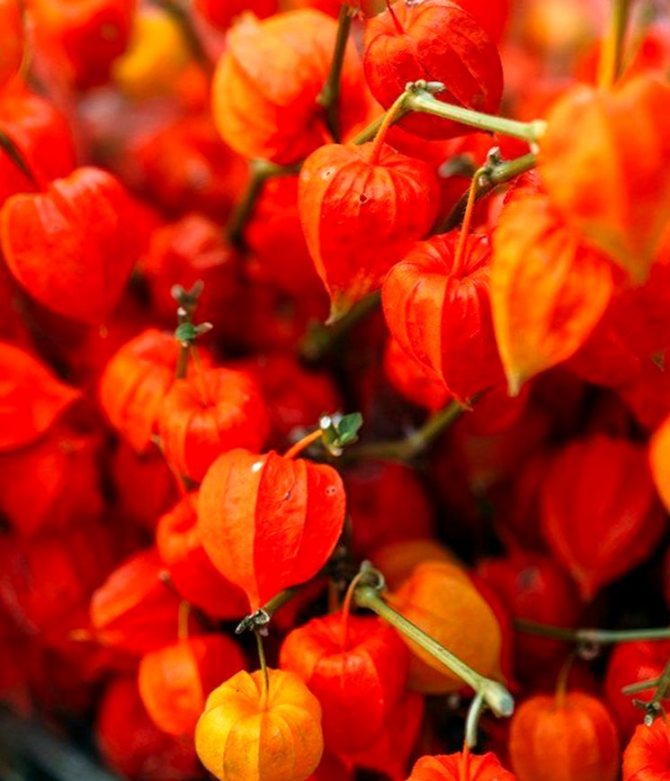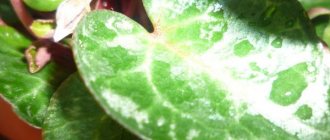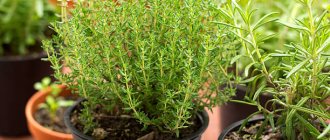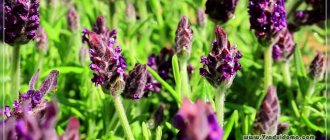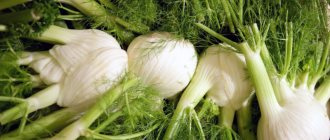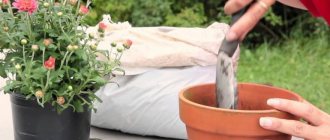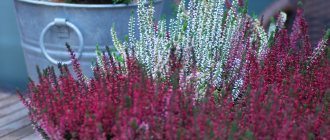Physalis is a plant from the nightshade family. Translated from the Greek language "physalis" means a bubble. The people call this plant differently: earthen cranberry, marunka, emerald berry, however, the most common is the bubble. This name is not accidental and it is associated with the shape of physalis - a growing red-orange calyx.
Some summer residents compare physalis with tomatoes. And although they are somewhat similar, in particular, in fruits, growing physalis, caring for it is very different from tomatoes. In addition, not all varieties of physalis can be used for food. There are purely decorative species.
The main varieties of Physalis
All types of Physalis are divided into three categories:
- Decorative Physalis. This species is also called physalis Franchet. The flower is extraordinarily beautiful and has the shape of a Chinese lantern. Bright orange boxes look great in the garden, they are a wonderful decor for flower beds. The peculiarity of this species is that Physalis Franchet grows on any soil, tolerates temperature changes well, does not require special care. Many gardeners prepare original winter bouquets from physalis boxes.
- Vegetable Physalis. Gardeners especially love him, since he not only adds beauty to the garden, but also gives edible fruits of orange or bright red color, from which you can make delicious jam, pickle. Fruits come in different sizes and weights - from 30 g to 150 g. Vegetable physalis is unpretentious in cultivation.
- Strawberry (berry) Physalis. Unlike vegetable physalis, strawberry fruits are much smaller. Their weight is approximately from 1 g to 4 g. Very rarely, fruits of this species can reach 9 g. Unlike ornamental and vegetable species, berry physalis is very sensitive to frost, the ripening period of fruits is much longer, but the taste is superior to all types ... In turn, berry physalis is divided into several varieties: raisin, Peruvian and Florida. It is from these varieties that you can make an amazingly tasty jam.
How to grow Physalis from seeds at home?
In southern areas, Physalis seeds can be sown directly into open ground. Moreover, in the future, this plant will not have to be bred, since it will multiply by self-seeding. It will only be necessary to transplant the seedlings to a specially designated place for them.
Sowing is done in mid-April. Seeds are introduced into a shallow groove, the interval between rows should be at least 30 cm. After the seeds germinate, the seedlings will need to be thinned out. The distance between the shoots should be 25 cm.
Attention! Seedlings transplanted to a new place will take root well, but they will bear fruit later than others.
Since Physalis is a frost-resistant plant, it can be sown before winter - in mid-October.
Growing Physalis through seedlings
Before proceeding with sowing seeds for seedlings, it is necessary to properly prepare the soil and soil. You can, for example, purchase a special soil designed for growing nightshades, or prepare yourself: 2 parts peat + 1 part compost + 1 part garden soil + ½ part fine sand.You can add a little wood ash to the mixture - this will reduce the acidity of the peat (for 5 kg of the mixture, you will need 2 salt spoons of ash).
When the soil is ready, fill the containers in which you plan to grow physalis. After that, start sowing seeds, but first they will need to be neutralized. This can be done as follows: take a small piece of gauze, roll it up in several layers, put the seeds, and immerse them in a manganese solution for about 20 minutes. In order for the seeds to sprout quickly, they can also be placed in a growth stimulant solution - Epin (for 100 ml of water - 2 drops of Epin).
The seeds prepared for sowing are planted in the ground at the same distance from each other, slightly from above, about 1 cm, sprinkled with soil, pressed down with the palm of the hand. After that, the soil must be carefully watered.
The container is covered with glass or a transparent plastic bag, placed in a bright and warm place (air temperature from + 15 ° C to + 20 ° C).
The first shoots will appear in about 7-10 days. Immediately remove the glass from the container, make sure that the soil does not dry out, water it in a timely manner.
When and how to pick seedlings?
It is necessary to dive the seedlings during the period when the sprouts reach the phase of 2-3 true leaves. The sprouts are transplanted into separate containers filled with soil, which is almost the same in composition as for sowing seeds. The only difference is a decrease in the amount of sand by about 2 times and the introduction of top dressing (for 5 kg of soil - 1 tablespoon of complex mineral fertilizer).
The soil in the container is compacted, such a deepening is made in it so that the roots of the sprouts can fully fit in it. After that, seedlings are carefully planted, covered with earth, watered with water. Seedling containers are installed in a well-lit and warm place. It is recommended to feed once every 2 weeks.
Seedlings should be hardened 20 days before planting seedlings in open ground - they should be taken out into fresh air, but provided that there is no frost.
Planting seedlings in open ground
The place for growing physalis must be prepared in advance. First of all, it is necessary to choose a site where nightshade crops have not previously grown on it - tomatoes, eggplants, peppers. It is imperative to fertilize the soil - add 50 g of nitroammophoska per 1 square meter. If the soil is too acidic, you can remove it with wood ash (300 g per 1 sq. M). It is imperative to dig the earth to a depth of 30 cm.
Make holes in the garden, plant physalis sprouts in them. The distance between the holes should not be less than half a meter, and between the rows - 70 cm. The seedlings are deepened to the first leaf, dug in, lightly tamped and watered with water.
In order for the seedlings to grow stronger, they must be watered, loosened, freed from weeds, and fed in a timely manner.
Attention! Physalis does not stepchild or tie up. The more branches it has, the more fruits will appear.
Berry physalis, unlike vegetable, is more capricious and less resistant to frost. However, it is quite possible to grow it on a balcony or windowsill. All your labor is offset by the sweet taste of the berries.
Features of growing vegetable physalis
Ornamental physalis ordinary reproduces by seeds and rhizomes, it is enough to plant it once and it will grow for many years. But the plant is very aggressive, so you need to constantly weed out excess seedlings or bury the restraints. In all other respects, planting and caring for it are similar to vegetable physalis.

Decorative physalis
- Seed preparation
- Land preparation
- Sowing in a seedless way
- Growing seedlings, terms
- Landing in open ground, care
- Ripening, harvesting
Seed preparation
Physalis has small seeds, therefore, in order to choose the best ones, you need to pour them into a glass with a 5% salt solution and stir.We remove those that float, and the best seeds that have settled to the bottom are washed and dried. They are ready to be sown.
If you want your seeds to germinate faster, see How to Speed Up Seed Germination for a variety of ways.
It is also good to hold the seeds a little in pink potassium permanganate before sowing.
Land preparation
The seedling soil should be light, fertile. Dig up the earth in the garden two weeks before planting seedlings with the addition of humus and ash. No need to add fresh manure!
Choose a bright, sunny place. Physalis does not like shadow and lowlands! As well as acidic soils. The best precursors can be cabbage or cucumbers. In second place are any other cultures. You can not plant after eggplant, tomatoes, peppers, potatoes, physalis itself, as they suffer from the same diseases.
Although it must be said that physalis is almost not damaged by any pests and diseases.
Sowing in a seedless way
Physalis vegetable is not afraid of the cold and reproduces well by self-seeding. Therefore, it can be safely sown before winter or in early spring in open ground. In this case, the seedlings turn out to be stronger, healthier, harder than home, but the beginning of fruiting is postponed until later. Therefore, if you want to get an early harvest, then you need to use the seedling method.
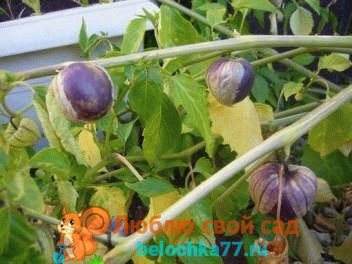

Vegetable physalis
Growing physalis through seedlings terms
It grows quickly, the age of ready seedlings for planting in the ground is 30 days. Therefore, we plan to sow seedlings in early April, in order to plant them in the garden in the second half of May. These are temporary recommendations for the Southern Urals and the Middle Belt. Naturally, you need to look at your weather. Vegetable physalis can be planted two weeks earlier than tomatoes, here's another guideline for determining the date of planting in open ground. But strawberry physalis is best planted with tomatoes, it loves warmth.
Growing physalis seedlings is similar to sowing tomato seedlings. You can first sow seeds in a small container and open them when two real leaves appear. Or sow seeds shallowly in separate cups at once to reduce damage to the root system during transplantation. Water abundantly, but infrequently.
Seedlings can be sown in a greenhouse or under a film on the beds. In any case, the seedlings need to be hardened, taken out into the street, gradually accustoming them to the sun. Young plants can get burned if they are abruptly moved from indoors to the sun. At air temperatures above 13 ° C, you can leave the seedlings outside overnight.
Top dressing of seedlings and planted plants is carried out every three weeks with a solution of mullein (1 in 10) or bird droppings (1 in 20). Water with fertilizer under the root so as not to burn the leaves.
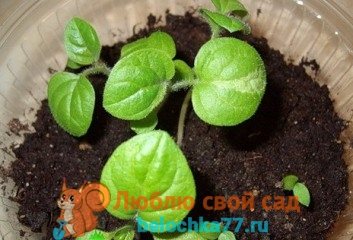

Physalis seedlings
Landing in open ground, care
About 30 days after germination, the plants will have 5-6 leaves and are ready to be planted in open ground. Physalis strongly branches and grows, so you need to plant it in a checkerboard pattern with a distance of 50 cm between the rows and plants. If the variety is tall, then you need to tie it to a support.
When planting, physalis is watered abundantly and then watered in dry weather. Mulch the planting and you will do many procedures much less often - loosening, weeding, watering. When pouring the fruits, it is better to stop watering so that they do not crack.
Physalis does not need to be grown-up, since the fruits grow in the axils of the twigs. The more the plant branches, the better the yield. To do this, you can pinch the top of your head at the end of June.
Strawberry Physalis
Ripening, harvesting
The lower fruits ripen first. They may start to fall to the ground. It's okay, collect them and recycle them! Unripe fruits are well stored and ripen at home. But for long-term storage (4-5 months) they are removed to the cellar with a temperature of + 2 + 3 ° C, laid out in boxes in two or three layers.
Collected for storage until frost in dry weather and always with a cover. Then an intact wax coating remains on the fruits, thanks to which they are stored for so long. Physalis ripeness depends on the specific feature of the variety. Some are painted yellow or lilac, the cap may be larger than the fruit or burst when growing, but when it becomes dryish and brightens, the physalis has ripened.
Usually in September there are many unripe fruits on the bush. So that the frost does not spoil them, dig up the bush by the roots, shake it off the ground and hang it in the shed for ripening.
Probably many have physalis in the garden. I have it and planted it again last year. Floral. His flashlights have been in our apartment all winter. This year I came across vegetable physalis seeds. And I bought it. For jam and canning. pictures of seeds on the right. Well, are there any differences from growing vegetable physalis from floral, ornamental. And how to cook it? I'll find out now :)
DESCRIPTION
Physalis is a very ancient cultivated plant. It was cultivated for another 7 thousand years BC. e. in the Americas. Our climatic conditions are also suitable for this vegetable, or rather, berry plant, but few gardeners know how to grow physalis, and therefore it is not very common in our country. But in vain! After all, in terms of taste, and especially in terms of the content of nutrients, it is in no way inferior to our favorite tomato.
Vegetable Physalis The plant is cold-resistant, annual, growing rapidly, fruitful, has medicinal properties, unpretentious. Fruits can be pickled, boiled for winter salads, dried, made hot seasonings based on them. It sprouts well by self-seeding. Not afraid of small frosts. Stores well.
Strawberry Physalis More thermophilic than vegetable. Fruits are small, like berries and sweetish, can be eaten fresh. Suitable for cooking preserves, jams, marmalade. When dried, it looks like dried apricots.
Delicious sweet fruits contain up to 12.5% of sugars, up to 1% of useful fiber, about 2 g of proteins, 1.2 mg of carotene, up to 30 mg of vitamin C. Also high in organic polyacids and lysine, a powerful natural anticancer substance.
FEATURES OF CULTIVATION OF VEGETABLE PHYSALIS
The seedling soil should be light, fertile. Dig up the earth in the garden two weeks before planting seedlings with the addition of humus and ash. No need to add fresh manure!
Choose a bright, sunny place. Physalis does not like shadow and lowlands! So are acidic soils. The best precursors may be cabbage or cucumbers. In second place are any other cultures. You can not plant after eggplant, tomatoes, peppers, potatoes, physalis itself, as they suffer from the same diseases.
Although it must be said that physalis is almost not damaged by any pests and diseases.
GROWING SEEDLINGS OF VEGETABLE PHYSALIS
Physalis is grown through seedlings. Its seeds are small. They are sown in March, first in cassettes, then diving in the phase of 3-5 leaves into peat pots. In such a way, not sprout and weak plants are rejected, which is often the case with crops with small seeds. To prevent the seedlings from stretching, the room should not be too hot. The optimum temperature is + 18-20 ° C. After picking, the seedlings are fed with complex fertilizer for vegetable plants. It grows quickly, the age of ready-made seedlings for planting in the ground is 30 days. Vegetable physalis can be planted two weeks earlier than tomatoes, here's another guideline for determining the date of planting in open ground. But strawberry physalis is best planted with tomatoes, it loves warmth. Fill a sowing dish with prepared potting soil, compact a little. Cover the top with the same soil mixture with a layer of 1 cm and compact it again so that when watering the soil does not erode and the physalis seeds do not float to the surface.Water the crops carefully, starting from the edge of the bowl, in small portions, waiting until the next portion of the water is completely absorbed. To prevent moisture from evaporating too quickly, cover the crops or place the bowl in a clean plastic bag and place it in a bright place. At a temperature of + 15 ... + 20 ° C, physalis rises in 7-8 days. After the emergence of seedlings, the shelter must be removed. Make sure that the soil in the bowl does not dry out.
HARVEST OF VEGETABLE PHYSALIS
Fruits are harvested as they ripen, before the first cold weather. They can crumble, but this does not affect the quality - fallen fruits can be collected from the ground. Those who do not have time to ripen must be collected before frost. In a warm room, they will ripen. You can dig up the plants before the onset of cold weather and hang them by the roots in the shed so that the remaining fruits gradually ripen.
Physalis fruits are hidden in caps of yellow-green or orange color. The surface of fruits, especially young ones, is sticky and oily. The most delicious are those that ripened on the plant in summer, in sunny weather. Late fruits are medium in taste, of which it is better to cook jam or pickle.
Before use, physalis is freed from the dry sheath and washed with warm water to remove the sticky substance. If not rinsed off, it tastes bitter. Fresh fruits are stored in a dry room at a temperature of + 2-4 ° C. without losing quality, 3-4 months, but they do not rinse before use for food.
The aromatic fruits of strawberry physalis can be dried in the oven at a temperature of + 40-50 ° C. periodically airing the oven. They will not dry out in the air - they will quickly deteriorate. Dried fruits resemble dried apricots. In folk medicine, physalis fruits are used as a diuretic for kidney and bladder stones. Decoction and infusions of fresh and dry fruits - for inflammation of the respiratory tract, stomach, intestines.
VIDEO
Physalis jam
RECIPES
1. Physalis jam with ginger
For the recipe you will need:
Physalis - 1kg granulated sugar - 1.2kg ginger (fresh root) - 20g water - 200g. To make Physalis Jam with Ginger you need:
Release Physalis from the cap. Pour boiling water over the fruit, wipe dry and prick with a fork. Wash the ginger, peel, cut into very thin slices, pour boiling water over, boil for 1 minute and, adding sugar in small portions, boil the syrup on this broth. In the syrup set aside from the fire, lower the prepared physalis fruits, stand for 1 hour and then cook over low heat until the physalis becomes transparent. Pour hot jam into small jars and close.
2. Physalis pickled
For the recipe you will need:
Physalis - 500g cloves - 2-3 buds bay leaf - a slice of hot pepper to taste
For the marinade:
Water - 1 liter salt - 50g granulated sugar - 50g vinegar - 1 tsp. To cook pickled Physalis you need:
Peeled and washed physalis fruits are tightly placed in jars, cloves, hot peppers and bay leaves are added, poured with marinade and sterilized for 20 minutes.
3. Salad with physalis, avocado and ham in chicory boats
Fresh chicory physalis avocado ham mayonnaise or yogurt (to taste) salt pepper
We disassemble the chicory into "boats" Cut each physalis berry into 6 parts of my avocado, peel and cut into small cubes. Cut the ham into small cubes. salt, pepper, season the salad to taste with either mayonnaise or yogurt and put it on the chicory Put the boats on a plate and decorate with physalis
SOURCES
Physalis is not as often found in our beds as we would like. So far, people are more prompted to grow it by the spectacular appearance of its decorative fruits of bright red color, and yet this culture is still a very useful and tasty vegetable, and it is not difficult to grow it at home, and even from seeds.
Ornamental physalis is a perennial plant and propagates both by rhizomes and seeds, but vegetable physalis is propagated only with the help of seeds, often using the seedling method. With it, you can grow well-developed plants and harvest a good harvest. Sowing physalis seeds in open ground often produces poor shoots, especially in dry spring. Meanwhile, the plant tolerates cold well and is completely unpretentious in care, and besides, its reproduction often occurs by self-sowing, thanks to the fallen ripe Physalis fruits. Its fruiting can last all autumn, in spite of even slight frosts.
When to remove physalis from the garden
After 3 months after germination, the fruits are already ripening, the ones from below are ready first. Dryness of sepals is a signal for collection. Physalis vegetable is also called gluten-fruited because of the characteristic bitter substance under the covers. To get rid of it, the fruits are washed and then eaten. Delicious berries, sweet and sour or sweetish, those that ripen in summer. Autumn is used for blanks.
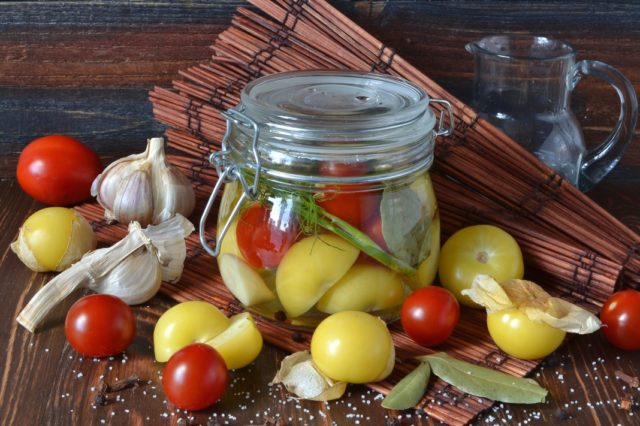

With a slight frost at - 1 ° C, the plant does not suffer. Unripe berries with an unreleased sticky substance remain in the refrigerator for 4-5 months. If the frosts are early, the plant is uprooted and suspended in a room where the fruits ripen.
Rejection of seeds
Physalis seeds are small and their quality of each of them is difficult to determine with a simple glance. In order to identify empty seeds that will not germinate, you should do the following. We take a glass, fill it with water, pour in two teaspoons of salt (no top) and mix well until everything dissolves. Then, pour the seeds into this solution and mix everything with a spoon.
The floating seeds must be thrown away, since they are unsuitable for sowing, and you will work with seeds that have sunk to the bottom.
This is the most promising planting material.
Main plant groups
In total, there are 3 main groups of physalis that are in demand today, namely:
- Decorative - this type of culture is the most common. The plant has a bush up to 70 cm high, its trunk is slightly lowered, but mostly straight, the leaves are oval. This physalis is perennial. Flowers of this species are inconspicuous, but this is not their appeal. This species is grown for the sake of unusual fruits, which are somewhat reminiscent of the famous Chinese lanterns. Up to 10 such fruits can form on one shoot. Due to such an unusual appearance, the branches of this flower are often used by florists and decorators to compose magical winter compositions. But it is worth remembering that the fruits of an ornamental type should not be eaten in any case, they are extremely poisonous;
- Vegetable - this native takes its roots from Central America, but appeared in the middle latitudes quite recently. Among the people, there are other names for the flower: earthen cherry, Mexican tomato, Jewish apple. The fruits of this physalis are large and can weigh up to 150 grams. As a rule, it is not accepted to eat it raw, since the fruits do not have a very pleasant taste, they basically undergo heat treatment before being put on the table. From such lanterns, you can make extremely original sauces or side dishes. If you canned such fruits, then with your eyes closed, you are unlikely to distinguish them from pickled tomatoes. Desperate culinary specialists prepare all kinds of jams and preserves from physalis, however, for these purposes it is better to use a berry look;
- Berry - this species is more demanding to care for. Its fruits are small and can be safely eaten raw. Physalis tastes like grapes, pineapple or even strawberries. These berries make excellent jams, compotes, fruit drinks and baking fillings. The fruits can be dried and then they will remind you of raisins.
Crop care
Crops should be regularly ventilated and the soil should be moistened.Plant pots should be kept in a bright and warm place. At a temperature of + 16 ... +20 degrees C, the seedlings will hatch in a week. When the seedlings hatch, the cellophane must be removed. When a couple of real leaves appear on the seedlings, they can be cut open. After that, water abundantly as needed. Seedlings should be watered carefully, trying to distribute a very small watering stream to the very edge of the pot. If necessary, add earth to the pot. This usually happens immediately after watering.
Landing in open ground
Since most types of physalis tend to branch, it is recommended to plant seedlings in a checkerboard pattern at a distance of half a meter. If you have chosen a tall variety, then in the future the plant will have to be tied up, do not forget about this fact when planting. The seedling hole should be of that depth so that it is enough for up to 1 leaf.
Before planting, water is poured into the hole and the seedlings are planted directly into it so that the roots straighten naturally. After that, the hole is covered with soil and carefully compacted. Seedlings that are planted on time do not need such manipulation; after planting, they just need to be shed well.
Top dressing
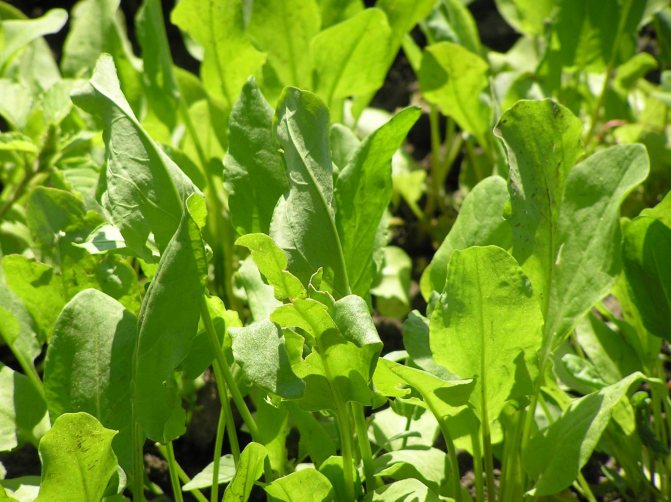

While the seedlings are growing and developing, they are fed every 15-20 days with an aqueous solution of mullein or bird droppings (1:10). You need to feed with great care. The solution is applied at the root, being careful not to get the solution on the leaves. After feeding, watered and then spud.
Organic fertilizing should be alternated with fertilizing with mineral fertilizers.
A tablespoon of complex mineral fertilizer is diluted in a bucket of water.
Diseases and pests
Physalis are resistant to disease, little susceptible to late blight. They are affected only due to improper agricultural technology:
- thickening of landings;
- too frequent watering;
- drought conditions;
- neighborhood with weeds, on which pests parasitize and pathogens of fungal or viral infections can develop.
Infection with mosaic viruses is especially dangerous when light spots appear randomly on the leaves, and the leaf blade wrinkles. Such specimens are removed with a lump of earth and burned. Do the same with plants with fusarium disease. They are recognized by the leaves withering at first from below, and then the whole bush withers away.
During the heat, aphids develop without sprinkling. On 10-12 bushes, it is taken out with infusions of soap or soda. Insecticides are used in large areas. Underground pests, bear and wireworm, gnaw at the roots. Wood ash is added to the site, which is not to the liking of insects.
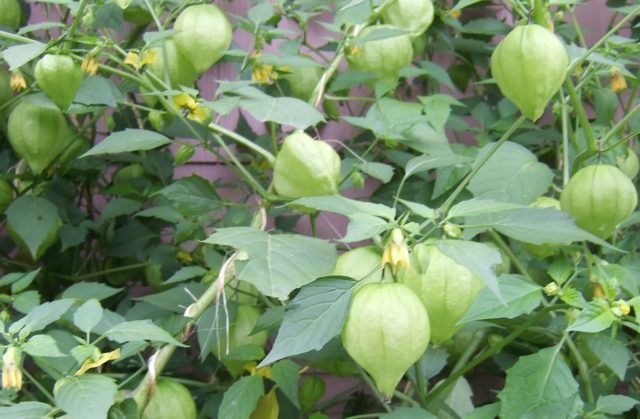

Sowing in the ground
Physalis can be grown by seed and in a seedless way. In this case, the plant will begin to bear fruit later.
Sowing before winter
Physalis seeds can be sown dry in autumn closer to winter. Plants grown in this way have a high drought resistance and are well resistant to various diseases.
Spring sowing
Physalis seed growing can be started in spring. You need to plant seeds when they hatch. To do this, place them in a damp cloth. When the sprouts hatch, the seeds are sown 1 cm in the ground.
Temperature
This is done in March or April, when the land in the garden warms up to about +5 degrees C.
Watering
It is necessary to water the seedbed sparingly every 2-3 days, but at the same time you need to monitor the moisture of the earth and try not to overdo it. In order for the seedlings to sprout together, it is better to cover the garden with cellophane.
Seed preparation and sowing
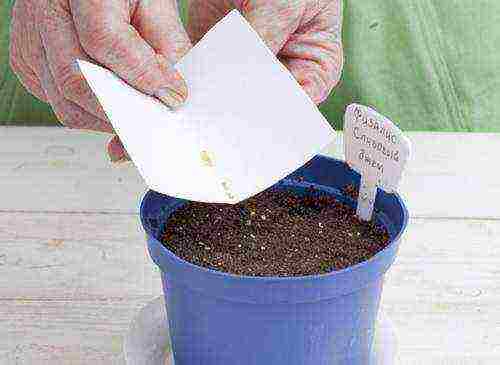

Seeds for seedlings are sown at the end of March - in the middle of April. Before sowing, they should be pretreated in a weak solution of potassium permanganate for 20 minutes. To improve germination, the grains are placed overnight in a solution based on a growth stimulator (for example, 2 drops of Epin per 100 ml of water).
Fill the container with the prepared substrate, tamp it slightly and lay out the seeds, keeping the same distance between them. Sprinkle with soil on top (no thicker than 1 cm), lightly press down on the soil and water. To create greenhouse conditions, cover the container with foil and place it on a well-lit windowsill.
After the shoots appear, remove the shelter. The most suitable temperature for growing seedlings is not less than 15, but not more than 20 degrees Celsius. The soil should be watered regularly, avoiding complete drying out.
Care
Caring for physalis is easy. It is necessary to loosen the ground under it, in a timely manner to deal with weeds and water. When the fruits begin to ripen, watering should be minimized to avoid cracking.
6 minutes read
When you first see physalis in the photo, it is difficult to guess that a ripe fruit is hiding inside its bright, airy orange cup. Its unusual structure served as fertile ground for the emergence of many poetic names for this plant - Chinese lantern, strawberry tomato, Peruvian gooseberry. Both decorative and edible varieties have a bright appearance. Therefore, do not be lazy to sow physalis - growing and caring will not only decorate the summer cottage, but also allow you to surprise the family with an unusual culinary dish.
Growing physalis and caring for it - complete instructions for the gardener
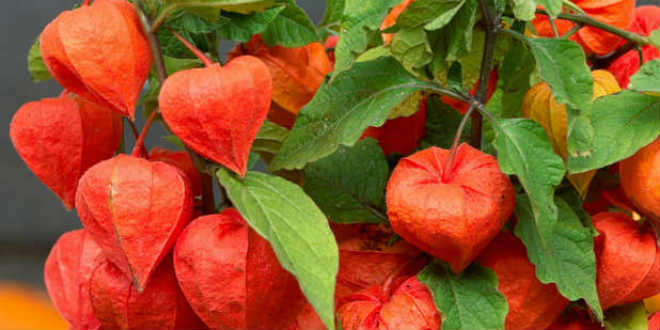

This original member of the nightshade family is classified into many species. There are more than a hundred of them. Three of them are known on the territory of the Russian Federation - one decorative (Physalis alkekeng, called a Chinese lantern) and two varieties of physalis suitable for food (strawberry Physalis pubescens, which is often called berry, and vegetable Physalis philadelphica). This article will help the reader understand all the nuances of caring for and growing physalis.
Plant features
Physalis is a herbaceous plant that can be grown both as an annual and as a perennial crop. These bright representatives of the nightshade family are used in ornamental gardening. Plants are quite tall, the length of the stem reaches about 60 cm. Light green oval leaves with a pointed end. The flowers have a nondescript appearance, decorativeness is provided by bright airy boxes, similar to thin paper bubbles, in which the tight fruits of physalis ripen.
Decorative physalis
With the onset of cold weather after the fall of the foliage in the fall, physalis does not lose its attractive decorative appearance. The fruits, covered with a thin film of red, orange pericarp, continue to stick to the stem. They are used not only outdoors, but also for interior decoration as dry winter bouquets.
Reference. In addition to decorative species, the planting of edible varieties of physalis in country beds has become widespread. Their fruits are pickled, salted, canned, used in salads, and jam is made from them.
Preparation of planting material
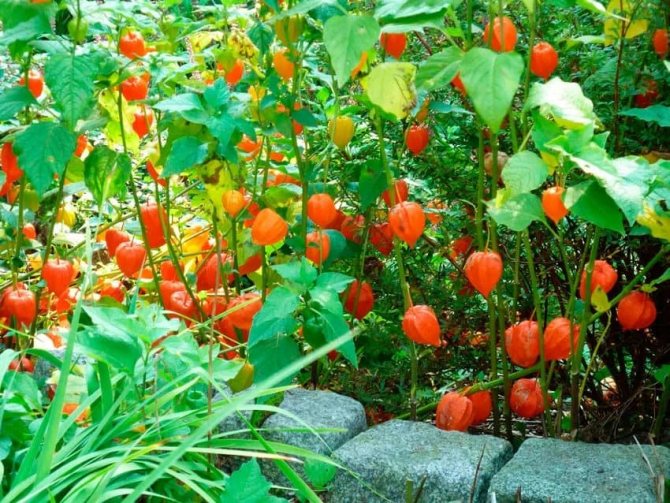

In warm areas, physalis can be sown with seeds directly into open ground, since this plant is quite cold-resistant. Surprisingly, you only need to sow physalis once, and then it will begin to multiply by self-seeding and you will only have to thin out the seedlings.
After 4 years of growth, the seeds of the plant will begin to lose their germination properties. To avoid blank sowing, soak the planting material in a salt solution, remove the floating specimens, and rinse the rest and leave for a while in a bright solution of potassium permanganate for about half an hour. Then rinse and dry the seeds.
It is better to start sowing physalis in April or even early May. Make grooves and fill them with seeds, but not thickly. Make sure that a distance of 30 cm is maintained between the rows.When most of the seedlings appear, they should be thinned out and leave 25 cm free between them.Those seedlings that you remove can be safely transplanted to another place, they will take root perfectly, but they will bear fruit a little later. Physalis can be sown in October, already just before winter.
Varieties and types of physalis
Physalis is the most numerous genus of the Solanaceae family and is a close relative of the tomato, although at first glance you cannot tell from the photo. The largest species diversity of this plant is present in countries in Central and South America.
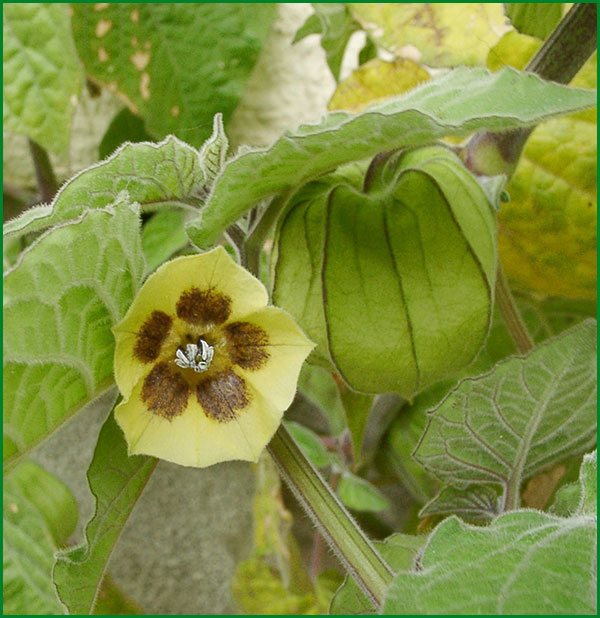

Peruvian physalis
Both garden and potted crops are known. In our area, in the open field, three varieties of physalis are often cultivated:
- Ornamental Physalis - Known as Franchet Physalis, among others. It is its orange-red pericarp that most resembles Chinese lanterns, which contain small fruits. Its planting is carried out as a decorative element of a flower bed. It is undemanding in terms of cultivation and care, it tolerates frost persistently.
- Physalis vegetable - stands out for large fruits - about 50 g, rapid growth and the ability to produce rich crops. Cultivation of a crop is not distinguished by complex agrotechnical techniques in the open field. Different varieties have their own flavors. In particular, "Korolek", "Moscow early" have a sweeter taste in contrast to the bitterness of their kind.
- Berry physalis - also called strawberry. Its fruits fully justify such a name, since rarely their weight reaches 10 g, on average they are no more than 5 g. Strawberry is less frost-resistant, the ripening period of the fruits is longer and the harvests from it are small. However, true gourmets are ready to endure such shortcomings for its excellent taste.
Reproduction
The vegetable species is propagated by seeds that can be sown outdoors in mild climates. In areas of the middle lane, the seedling method is more acceptable. The physalis fruit left by chance for the winter in the spring can germinate with several seedlings, the fruits of which will ripen only in September.
Decorative varieties for open ground propagate:
- seeds;
- cuttings;
- dividing the bush.
The grains are sown, as in the vegetable species. Cuttings are cut in July, choosing a fragment with 2-3 buds. Rooted using standard methods. Creeping rhizomes are separated in spring and autumn. The bushes take root quickly.
Preparing for landing
For those who are familiar with the agricultural technology of tomato, it will not be difficult to grow such a plant as physalis - planting and caring for them are very similar. But compared to tomatoes, physalis in the open field is less demanding on the illumination of the area chosen for its reproduction.
Physalis raisin fruits
Success largely depends on the correct composition of the soil. For sowing take:
- 2 parts of peat;
- 1 part compost;
- 1 piece of garden land;
- 0.5 parts of clean sand.
Important. Physalis reacts poorly to high soil acidity. To reduce its level, for every 5 kg of soil mass add 2 tablespoons of ash.
How physalis grows
When growing physalis from seeds, grain can be sown directly on the site only in the southern regions, where there is no threat of return frosts. In all other areas, from the beginning of the month, seedlings are taken care of indoors. If desired, vegetable physalis is planted on the balcony in tubs of 10 liters of soil. Several bushes are grown nearby, because the culture is cross-pollinated. Since the plant belongs to the nightshade, caring for it is the same as for tomatoes. Self-seeding plants often sprout from the fruit left for the winter in the open field in spring, which also bear fruit abundantly.
A characteristic feature of physalis is a berry-shaped fruit, similar to a medium-sized green tomato, which is in a shell, a dry sheath formed from intergrown sepals. In a decorative species, the orange-red berry is tiny, in fruit trees, weighing 30-90 g, green, greenish-yellow or purple in color.
On one plant in comfortable conditions of open ground, 150-200 fruits are tied, with a total weight of 3-5 kg.
Different varieties of vegetable species produce round, flat, oval, smooth or ribbed fruits. Plants are also excellent in structure. There are tall specimens up to 1 m, with branches that rise obliquely upwards. In semi-growing varieties, the branches tilt down. Leaves are ovoid, smooth, flowers are small, yellow.
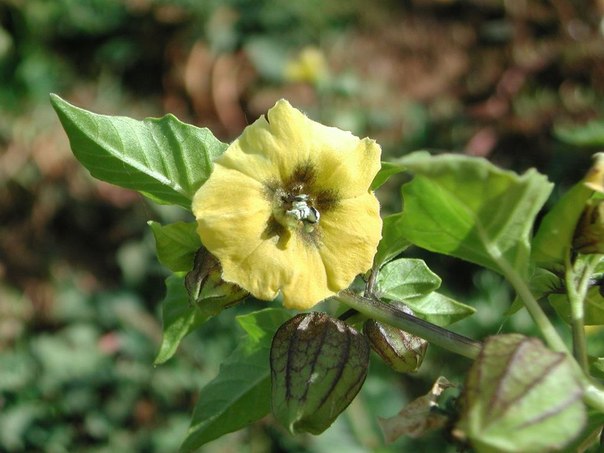

Important! The fruits are formed in the axils of the twigs. If there are many branches on the plant, there will be more berries. Therefore, vegetable physalis in the open field is not stepchild.
Planting physalis
Physalis propagation is carried out through seedlings. It is planted in open ground upon reaching the age of 45-50 days, when the threat of frost has passed. Therefore, the date of planting seeds in spring from this calculation is performed in mid-April.
Physalis seedlings
Planting includes the process of disinfecting seeds and nutrient substrate. The soil is treated with steam or heated in an oven. The seeds in a gauze bag are dipped in a weak, barely pink solution of potassium permanganate for half an hour. After such preparatory measures, you can start sowing. For this:
- Fill containers with sifted soil and lightly compact the substrate.
- The seeds are pressed into the surface at an equal distance from each other.
- Pour earth on top with a thickness of no more than 1 cm.
- The surface is compacted, after which the first watering is carried out.
- Crops are covered with transparent polyethylene or glass and left in a well-lit place.
- The temperature in the room is maintained at the level of + 15 ... + 20 ° С.
- If the care was correct, seedlings will appear after a week. From this moment, the shelter is removed. Maintenance measures include regular watering.
The next stage of reproduction is picking seedlings. It is started when the first 2 real leaves appear. In the composition of the soil mixture, the amount of sand is reduced by 2 times. In addition, fertilizer is added to the picking soil - 1 tablespoon of mineral dressing for every 5 kg of nutrient substrate.
Planting is done in separate cups. A hole is made in the ground deep enough to fit the roots of the seedlings. Moderate watering is required after planting. If after that the earth has settled, add more soil mixture.
Seedling care is simple:
- The cups are kept in a place well-lit by the sun's rays.
- The air temperature is maintained at + 15 ... + 20 ° С.
- The soil is kept moist; the earth should not be allowed to dry out.
- Fertilizer for seedlings is applied every two weeks.
Important. So that planting seedlings in open ground does not end with the death of immature plants, it is necessary to temper tender sprouts in the spring. To do this, in good weather, they are taken out for an hour and a half to fresh air.
In the area set aside for physalis, other nightshades should not have grown over the past few years. If eggplants or eggplants were previously cultivated here, your physalis will develop poorly.
In the process of digging, fertilizer is applied - no more than 50 g of nitroammofoska per 1 square meter. Conduct soil acidity tests. If it is raised, it will fix the glass of wood ash.
The planting pits on the ridges are placed at least 50 cm. The distance between the rows is about 70 cm. The seedlings from the cups together with the earthen lump are placed in the hole. Planting depth - to the bottom leaf. The soil around the stem is carefully tamped. After planting, the soil is irrigated and mulched with peat.
The choice of physalis varieties for growing on the balcony and windowsill
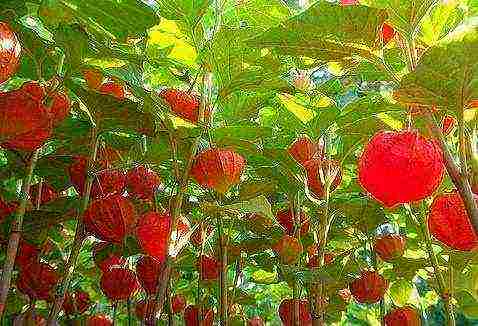

Physalis on the windowsill
The Raisin variety gives sugar berries that are not large in size, but have a bright aroma and a very pleasant taste. The fruits can be eaten fresh, dried, processed.
The Pineapple variety produces small fruits. Their aroma is similar to pineapple, the taste is sweet, very pleasant. The appointment is universal.
Strawberry Physalis forms bushes about 70 cm high.Fruits are small, amber, very sweet, with strawberry taste and aroma. The appointment is universal.
Growing physalis on a windowsill
How to grow physalis at home? For planting on loggias, seeds are used - they are sown in March, after having kept for 20 minutes in a pink solution of potassium permanganate, and then dried. If there is any doubt about the germination of seeds, you can hold them for 12 hours in water mixed with Epin (1-2 drops / 100 ml).
The soil mixture is prepared from peat, humus, turf and sand (2/1/1 / 0.5). If the peat has an acidic reaction, add wood ash (0.5 st. / 5 l). The mixture is steamed for an hour to get rid of possible pests.
The depth of immersion of the seeds is 1-2 cm. The sowing is watered with warm water and left on the sunny side, covered with a film (it must be removed daily for airing).
Seedlings are transplanted into separate pots after a couple of leaves appear. Drainage is placed on the bottom and the pots are filled with soil mixture prepared according to the previously indicated recipe (the sand rate can be reduced, and mineral fertilizer should be added to 5 liters of the mixture - 1 tablespoon). The plants are deepened to the cotyledonous leaves. The earth should not reach the edge of the pot by 1/3 of the volume. As the plant grows, soil must be added to form a strong root system.
Physalis care on the balcony and windowsill
Since fiazlis needs 12-hour daylight hours, in March the plants are illuminated for 3-4 hours. Watering should be regular. At first, the plants are shaded from direct sunlight. With an interval of 2 weeks, they are fed, alternating organic matter (mullein / water - 1/8) and a complex of minerals (1 tablespoon / 1 bucket). The forming stepchildren are cut off. If necessary, the plants are provided with support.
Physalis is easy to grow in a pot at home - it is only important to follow the rules indicated above. Sweet fruits will be a worthy reward for you.
Mir-
When copying materials from the site, keep an active link to the source.
A friend treated me to physalis jam, which grows in her country house, and gave some seeds. I really liked its unusual taste, I decided to breed it for myself. Tell me how to grow physalis seedlings at home?
Physalis is a member of the nightshade family and comes in both decorative and edible varieties. Due to its good frost resistance and unpretentious care, the plant has gained popularity among gardeners. So, decorative varieties serve as an excellent decoration for flower beds, and delicious jam is prepared from edible species, and fruits are pickled and dried for medicinal purposes.
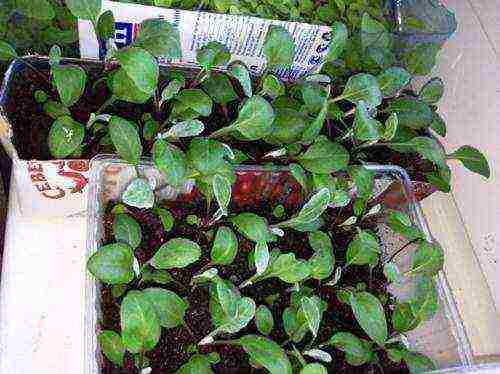

Both types of physalis at home are most often grown in seedlings. To get high-quality seedlings, you should competently approach the following questions:
- Selecting a suitable soil for sowing seeds.
- Seed preparation followed by sowing.
- Shoot picking.
- Seedling care.
Physalis strawberry - what is it?
Annual frost, Cape dwarf gooseberry, strawberry tomato, Barbados physalis - all these names are assigned to the same plant - the hero of our story. An annual self-pollinating plant that can be grown with equal success both in the garden and on the windowsill is an excellent choice for those who like to plant something unusual.
In height, it grows up to 35-40cm, its stems either spread or are raised above the ground. On the bush, berries ripen with a diameter of 6-12 mm and weighing from 3 to 5 grams. The orange color of the fruit reminds us of either persimmon or tangerine, in general, it evokes only positive emotions. They intensify when you inhale the pleasant strawberry aroma of the fruit and taste it, by the way, sweet.
Ripe Physalis Fruits Green Physalis Lanterns Blooming and Ripening Physalis Lantern Ripe Physalis Fruits
When to harvest and how to store a crop of physalis
The crop is harvested from the end of July until frost. Do not pick physalis fruits after rain and in the morning before dew melts.They begin to be torn off when the covers become lighter and dry. Ripe fruits of vegetable physalis are green, yellow-green and yellow. The surface of the fruit is covered with a thin oily film, the pulp is dense, with a large number of light seeds, sweet and sour taste with a fruity aroma.
In addition to ripe physalis, green ones are also removed. Unripe and undamaged dry fruits are well preserved until spring. The collected physalis is immediately cleaned of caps, placed in boxes (3 kg each) and stored at a temperature of 12-14 ° C. At a higher temperature, the fruits ripen quickly and deteriorate. Fresh fruits are hardly edible due to astringent nightshade-tart aftertaste, but very useful. But they can be salted, pickled, dried, they make excellent caviar, as well as delicious jam, jam, jelly.
Before cooking, physalis is thoroughly washed in hot water to remove the sticky substance that is on the surface and gives the fruit bitterness.
Which physalis to plant?
The most popular among vegetable growers are Mexican and strawberry physalis. Mexican physalis has erect bushes 80-100 cm high. Fruits are large (30-60 g) of green, yellow or purple color, depending on the cultivar. The most common varieties of Mexican physalis are Moscow early, Gruntovy mushroom and Confectionery. All of them were bred by Academician A.V. Alpatiev and are well adapted to northern conditions.
Moscow early - an early ripe variety with large fruits (60 - 80 g), which, when mature, have a yellow color. The calyx fits snugly against the berry. Ripe berries are sweet. They are not only salted and pickled, but also processed into sauces, mashed potatoes, caviar and jam.
Ground mushroom ripens a little later. Fruits are large, greenish, cups are tight-fitting. Ripe fruits are sweet and sour. They are edible fresh, baked and salted, and can be used in soups.
Confectionery physalis has smaller and more acidic fruits than previous varieties, but has a great gelling ability.
Strawberry Physalis is sweeter than Mexican. Plants are low (60-70 cm), creeping. Fruits are small, amber-yellow or orange, sour-sweet with a pleasant strawberry aroma. Common varieties of strawberry physalis - Strawberry and Raisin early ripening. Strawberry physalis is used to prepare filling for pies, candied fruits, add it to compotes instead of raisins.
Physalis after flowering
Seed collection
The berries are torn off along with slightly dried out spectacular cups on a sunny day, 1.5–2 months after the physalis is transplanted into open soil (in August or September). Ripening of berries does not occur at the same time, so those from the bottom become ripe much faster and fall to the surface of the site.
They can be collected and used for food or for recycling. Also, seeds can be extracted from these berries, if necessary. Take ripe berries and use a knife to divide them into 2 halves. Then they should be immersed in rainwater for 24 hours, and then the pulp is rubbed through a sieve. The seeds must be washed and dried.
Wintering
If a decorative perennial physalis is grown, then the aerial part should be cut off in the autumn. It can be used to create very beautiful dry bouquets. The leaf plates must be cut off, and the shoots with fruits, which are hidden in bright covers, are hung up so that they dry. The surface of the site for the winter should be covered with a layer of mulch (peat). Berry and vegetable annuals after the fruits are harvested must be disposed of, after which the soil on the site should be dug up.
Contraindications
The use of this berry has its own nuances that you should know so as not to face serious troubles.
Firstly, the berry has a bract, which contains toxic substances, so you always need to get rid of it before using it.
Secondly, physalis is categorically contraindicated for people with high acidity of the stomach.
Thirdly, some may have an individual intolerance, which can cause an allergic reaction. This point must always be taken into account, and at the initial intake it will be limited to the minimum portion or dosage.
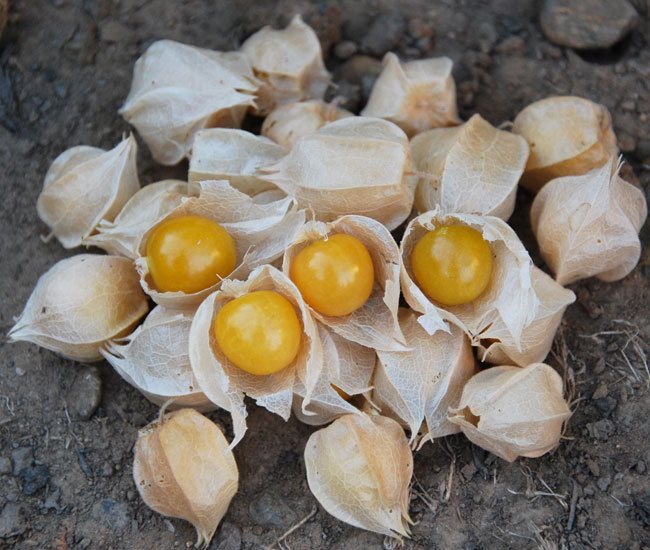

Physalis is edible and inedible - how to distinguish?
Decorative physalis has beautiful large lanterns and small berries inside. These berries taste bitter and are not suitable for cooking. For garden or apartment design, these Chinese lanterns are very suitable.
Edible physalis
Edible physalis looks much more modest than decorative. But they have a large fruit that resembles a small tomato.
Many different wonderful dishes can be prepared from the fruits. This American fruit fits easily into our everyday cuisine. Therefore, using your imagination, you can prepare various culinary masterpieces.
But in the technology of cooking physalis fruits there is a little trick. It is necessary to wash off the sticky plaque from the fetus. To get rid of plaque, you need to pour the fruits with boiling water for five minutes. After such processing, the bitterness of the fruit will go away.
Pickled physalis
Ingredients:
- 1 kg - vegetable physalis.
- 50 gr. - spices.
- 50gr. - sugar.
- 2 tbsp - vinegar 9%.
- 3 large cloves of garlic.
- 1L. water.
We wash off the sticky bloom from the berries and lay in layers in a prepared container, sprinkling with spices. For spices, take various leaves: currants, parsley, dill. Prepare the brine - for this, pour sugar and vinegar into the water according to the recipe.
Bring to a boil and pour the brine into a jar with fruits for about half an hour. Then we pour this brine into a saucepan and boil it a second time. While it boils, finely chopped garlic is placed in the jars. When the brine boils, it is poured into a jar and rolled up.
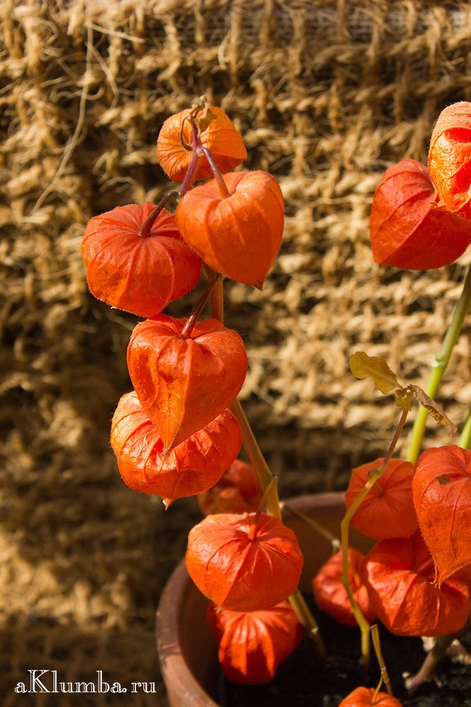

Physalis jam
Ingredients:
- 1 kg. physalis.
- 1 kg. Sahara.
Cut the fruit and add a glass of water. Bring to a boil, and as it warms up, add sugar. Next, we boil the resulting mass in a steam bath. And so we cook until the jam thickens. Further, if you wish, you can eat right away, or you can roll it up in sterilized jars.
Description
General information
The genus Physalis (Phýsalis) belongs to the family Solanaceae (nightshade), to the same family scientists - taxonomists include tomatoes, potatoes, eggplant, datura and henbane. However, this orange "bubble" is a giant among the rest, in addition, its stem is even capable of lignification. It differs from other members of the family with its unique, beautiful pericarp. This box, similar to a luminous flashlight, is a cover formed by the fused sepals of the former flower.
Physalis has been known in Russia not so long ago, but, gradually spreading, it won the sympathy of many gardeners. A wonderful and original appearance, the ability to use it as a vegetable plant and even serve it to guests in the form of a fruit dessert, decorativeness until late autumn - everything is fine in physalis.
True, the names that he received among the people are rather funny - bubble grass, sleepy grass, cherry dogs.
Bubble grass comes from South and Central America, quite a lot of it in Peru, Colombia, physalis is also grown as a crop in Mexico, Guatemala, Venezuela. Since the plant is very thermophilic, it is there that it feels comfortable, which allows it to breed more and more new varieties with improved characteristics.
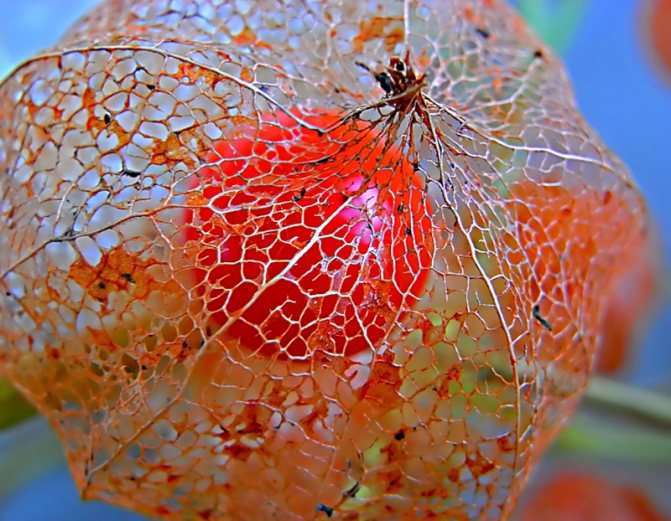

Myths, legends, superstitions
Physalis is legendary. Here is one of them:
The world has not always been dominated by light. Once, a terrible thing happened - the beautiful Sun disappeared in the Dragon's gut. Darkness fell to the ground, death was reigned. Life stopped, all living things hid, those who did not have time died, emptiness swallowed the world.But there was a man who decided to defeat the terrible Creature, rescue the Sun and return Joy and Light. With empty hands, he went to the Dragon, and only illuminated his path with a small flashlight.
The struggle was terrible, mountains and rivers groaned, but Evil is always punished. And the Dragon fell, releasing the Sun from its depths. It flared up like a huge bonfire, reflected in a small lantern dropped by the Daredevil, and multiplying a hundredfold, the Light scattered over the grass, turning into an unprecedented number of glowing lanterns. Physalis was born.
Not spared "gooseberry with a lid" (another name for physalis) and the teachings of Feng Shui. “This is the best flower that saves you from boredom,” its connoisseurs tell us: “Place a vase with a bouquet of physalis in the darkest place of your house. The branches will illuminate him, banishing longing and boredom. "
It is the seeds of the plant that have a particularly strong energy. If you hold them in your hand, make the most cherished wish, and then plant them - then everything will definitely come true. But when physalis rises, begins to rise, it will attract good people, for young women - betrothed, benevolence and goodness will reign in the house.
However, to get a positive effect, physalis must be correctly positioned. In dark, closed corners (for example, corridors), a flower can lose its energy, it is better to place it in the sun.
If the dried "lanterns" are put on the windowsill or hung over the door, the house will be protected from the evil of the other world.
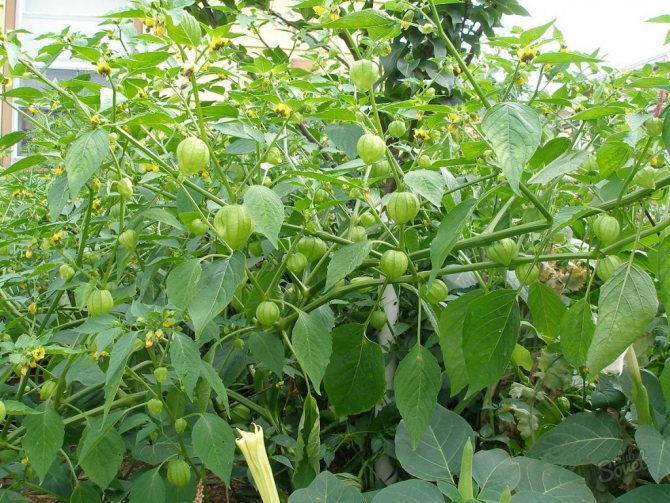

A bit of botany (botanical and varietal features)
The following varieties of physalis are known.
Vegetable
Descended from fairly hardy, cold-resistant Mexican species. It has a highly branching stem with elongated yellowish, purple or green leaves. The fruits of this physalis are very large, with different shades, depending on the variety, the mass reaches 80 g. In order to eat them, it is better to remove the plaque - it is bitter.
Strawberry
Another name for the variety is berry. Originally from South Africa. On pubescent stems, beautiful, corrugated leaves. The fruits are not very large, up to 10 g, but sweet, with some even strawberry flavor, without bitterness, beautiful yellow or orange color.
Decorative
Most often grown in summer cottages, it is used as an autumn decoration of flower beds. It can be high or low, decorated with bell flowers of white, blue and even red. But the most decorative it becomes closer to autumn - you cannot take your eyes off the graceful stems, strewn with multi-colored (often bright orange) lanterns.
Soil for physalis
When choosing a soil, focus on acidity. In even slightly acidic soils, neither decorative nor fruit physalis can grow, so make sure the soil is calcareous or neutral before planting. Also, strictly avoid places with stagnant water, high levels of groundwater, swampy and compacted areas.
Choose a loose, well-drained, high-quality soil with a high nutrient content to be successful in growing this plant.
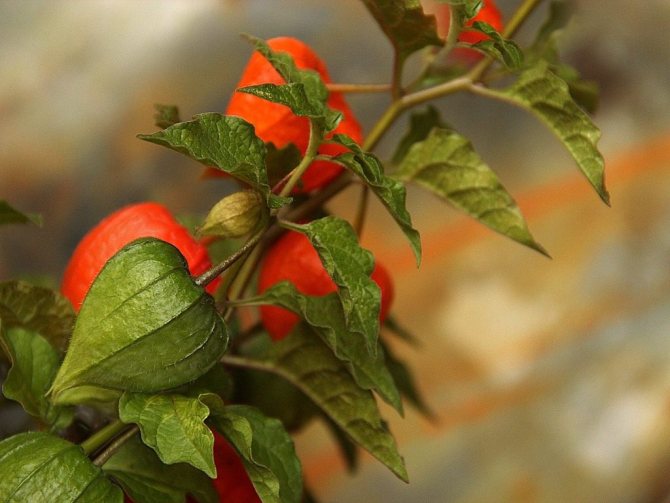

Physalis.
Physalis: combination with other plants
It is very difficult to find neighbors who would emphasize the beauty of a bright perennial better than he does it himself. It is often planted "for the future" to decorate winter landscapes. Orange lanterns, sprinkled with snow, enliven the half-empty gardens. In addition, growing physalis almost always involves its use in dry compositions.
Physalis on a flower bed
In them, it is good in combination with kermek, lunaria, gypsophila, immortelle, spherical homphrene. Ensembles of “strawberry tomato” and pine needles look really festive and unusual. Physalis looks harmoniously surrounded by clusters of rowan or viburnum, as well as spikelets. And even a bunch of ordinary autumn leaves will turn this bright plant into a colorful bouquet.
Variety selection
Before growing physalis, it is worth determining what it is for.
The Franchet variety, unpretentious and frost-resistant, is suitable for performing decorative functions.
Vegetable varieties are close to ornamental in characteristics, but the fruits are edible. They make delicious and aromatic jam: growing pineapple physalis from seeds will allow you to get fruits with a pronounced pineapple smell, which remains after heat treatment.
Berry physalis is inferior in yield and frost resistance, however, the taste characteristics have different shades and nuances: when grown from the seeds of physalis Rahat Lokum, you can get early fruits with a strawberry-pineapple taste.
Features of varieties of physalis
Physalis decorative - perennial. Differs in unpretentious care, resistant to low temperatures, so there are no problems with growing this type of plant. Shoots with fruits in the form of lanterns of an original shape are used to decorate the premises. If they are placed in flowerpots and not disturbed (a dry plant is very fragile), then they can delight the eye with their beauty for more than one year.
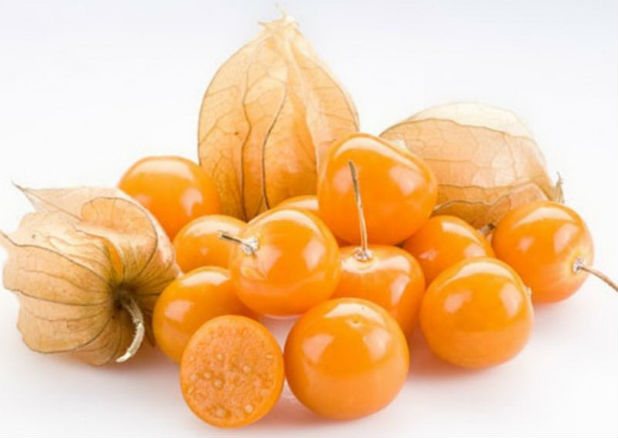

Physalis vegetable - is resistant to low temperatures and high yields. This type of plant belongs to annuals, with large (up to 50 g) fruits. They are easy to store for a long time. Used for making salads, seasonings, pickled. The varieties "Moscow Early" and "Korolek" have a sweetish taste, therefore they are the most cultivated in garden plots.
Physalis berry (strawberry) - a more thermophilic culture, giving small fruits (up to 8 - 10 g). They are used either fresh, or go to the preparation of marmalade, jams, preserves. The difficulty of breeding is that the ripening process takes longer than other species of this plant. But this is fully compensated for by the high taste of the fruits, for which they are appreciated by gourmets.
Ideas for decorative compositions with physalis
With the help of these tips and your own imagination, you can easily decorate your apartment, house or garden plot:
- place the physalis in an openwork vase made of wood. Place a pumpkin next to it, making a funny face out of it (by gluing or cutting out eyes, mouth, etc. with a knife);
A bouquet with physalis can stand in your room all winter.
- place perennial sprigs in a beautiful flower watering can;
- you can put "lanterns" in a round aquarium without water or in another transparent container of the same shape;
- decorate walls or doors with wreaths. Sometimes ordinary photo frames are used for their basis;
- weave the twigs into a beautiful pigtail, decorating it with beads, ribbons, a small hat;
- make an original topiary (artificial "money tree");
Physalis decor
- string physalis boxes on stainless wire and braid a vase or container for cereals or spices with it - the kitchen will be transformed;
- for New Year's decoration at home, create a composition with candles and pine branches.
In summer, admire physalis in the open field, in winter, do floristry and feast on exotic "strawberry tomato" jam. The versatility of this wonderful plant deserves that you not only admire it in the photo, but also grow it yourself.
Collection and storage of physalis
It is better to collect it at the time of biological ripeness, when the fruits acquire a characteristic color and have a fragrant smell. The color of the fruit depends on the variety. They can be light yellow, deep purple, and even green. For example, the Gruntovy mushroom variety, which is quite common in temperate latitudes, has yellow-green fruits, and the “Confectionery” variety is simply green.
Biological ripeness can also be signaled by wrapper covers, which begin to dry out and crumble.You can also focus on the following terms: biological maturity in most varieties occurs under favorable weather conditions about 60 days after planting seedlings and 80-85 days after germination in seedling Mexican physalis. Ripe fruits fall off and in dry weather they can lie on the ground for a long time without spoiling. Large unripe fruits ripen well in a warm room. Physalis can be harvested until frost. It is not advisable to pick fruits with damp covers in the morning or after rain. If you have to collect them raw, then they must be dried and separated from the cases, otherwise they will quickly deteriorate. Dry fruits are not cleaned from the covers. On the eve of frost, you can dig up physalis with unripe fruits and hang it upside down in a barn, on a veranda, on a glazed balcony: the fruits will gradually ripen there.
That is, perhaps, in short, everything related to useful properties, cleaning and storage. As for planting, growing and processing physalis, this is a topic for a separate conversation.
Physalis vegetable: useful properties, recipes
The beneficial properties of physalis have become known not so long ago. This plant came to cooking from Latin America (more precisely, from Mexico), where they began to grow it specifically for use in food.
Physalis edible is divided: vegetable and berry (or strawberry), from which you can prepare a lot of delicious and 2 types of healthy dishes. The third type of this plant is exclusively decorative, it is not eaten, but it serves as a wonderful interior decoration.
If berry physalis tastes sweet, then vegetable physalis, on the contrary, has a piquant bitterness, despite which not only canned and snacks are prepared from it, but also desserts (preserves, jams, candied fruits, etc.). That is, the range of application of this plant variety in cooking is quite wide.
To prepare dishes from vegetable physalis, especially fruitful varieties are often taken:
- Kinglet;
- early Moscow;
- Tomatillo;
- Gribovsky soil;
- Condite and others.
Any of the listed varieties is quite suitable for preparing delicious and healthy dishes.
Possible problems
Physalis is an unpretentious plant with powerful immunity.
However, it must be remembered that, like any representative of the Solanovykh, he can be ill with fungal diseases, suffers from untimely ripening of fruits.
It also needs to be properly formed. To obtain a good harvest, the plant is formed by pinching the tops, since the more the main shoot branches, the more there will be places for laying fruit buds.
If the summer is unfavorable in terms of weather conditions, physalis is spud to increase disease resistance and improve the ripeness of the crop.
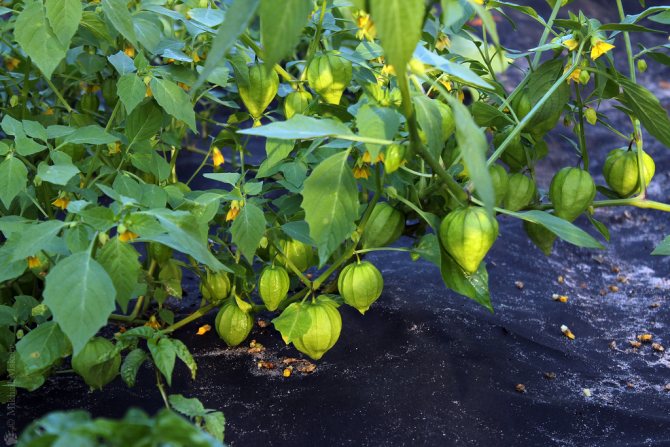

Main features of strawberry physalis
The main difference from the usual type of physalis is the period of "life", vegetative processes and taste of smaller fruits. Physalis strawberry is considered an annual plant that can bear fruit without problems not only on your site, but also on the windowsill, delighting with its rich harvest all year round.
The plant, during its growing season, forms low bushes, which most often has 35-40 cm in height, on which small orange fruits are densely formed, which have incredible aromas, which justifies the name of the species. The fruits are quite small, since their diameter varies from 5 to 12 mm, and their weight ranges from several grams to 5.
A bright shade, rich aroma, juiciness and excellent sweet taste of the fruit, is the basis for fresh consumption, jam, and even drying according to the technology of making raisins. Strawberry Physalis is grown exclusively in a seedling way, since this plant is thermophilic, and the growing season is on average 100 days. Therefore, in more detail about all the moments and stages of growing physalis at home, we will describe below.
As already mentioned, for full growth and successful ripening of fruits, it is necessary to initially grow seedlings, and only then engage in planting in open ground.
Like any seedling, strawberry physalis needs minimal, but strictly observed conditions, which can guarantee rapid plant growth and maximum germination. It is necessary to cultivate strawberry physalis seedlings in March. The best container for the first planting of seeds is a special container for seedlings, which is called a cassette. You can use other options at your own discretion, but it is the cassette that is the guideline.
For successful germination and maximum seed germination, experienced gardeners recommend soaking the seeds, wrapped in gauze in a sufficiently concentrated solution of potassium permanganate for 15-20 minutes, which will help to give strength to the seeds and resistance to common diseases. Next, you should purchase a growth stimulator, dilute according to the instructions, and soak the seeds for the specified time.
Seedling soil
Like vegetable physalis, strawberry can be grown on commercial substrates that are intended for peppers or tomatoes, or you can prepare a mixture yourself, which will be the best "home" for seeds. For your own soil mix, you will need even pieces of humus or compost with garden soil, add double peat and half sand to these.
Planting process
The prepared mixture or substrate must be filled tightly enough, the seeds must be placed on top and sprinkled with the same earth, forming a globe with a height of 1 cm.Further, it is imperative to create a greenhouse using glass, film or a cover. The greenhouse should remain until all the seeds hatch well, then it is necessary to move on to airing the seedlings, and soon completely abandon the "shelter".
Seedlings of strawberry physalis need minimal, but complete care. Since the plant is thermophilic, the temperature should not drop below 20 degrees, it is better if it is several degrees higher. Watering must be done often, but without fanaticism, avoiding stagnation of water. The irrigation procedure must be carried out with warm water. Seedlings are very fond of the sun,
Dive seedlings
When the seedlings grow up, and the first 3-4 leaves are formed on it, it is necessary to start the diving procedure. For this, the best option will not be separate containers with a substrate, but peat pots or tablets, which will balance and give strength and power to the physalis seedlings as much as possible. The transplanting process must be carried out until the first leaves, which are well compacted around the perimeter and watered with warm water, so if you notice that the seedlings are stretching out, this is the first sign of insufficient lighting.
Since the plant will soon be transferred to open ground, it is necessary to carry out a hardening procedure, which will help to quickly adapt and transfer this procedure painlessly. The first hardening should start in April, gradually increasing the time spent on the balcony. Initially, it is enough from an hour to 3, then, with strengthening and increasing the seedlings, it is worth gradually increasing the duration of this procedure. A glazed balcony with open windows will be a great place for moderate rather than extreme hardening of seedlings.
Do not forget that strawberry physalis is a heat-loving plant that prefers to grow in open areas where the shadow is minimized, if such an arrangement is not possible, then it is necessary to minimize the shadow. An important aspect is which of the "predecessors" lived in this place earlier. For physalis, this moment is very important. Try to have any legumes, cabbage, cucumbers or potatoes growing there earlier.
Remember that seedlings should be planted in open ground in May, but even at this time, changes in weather conditions are common practice, so you should get a film that will save you from the first "tests" for strength. Planting should be carried out, adhering to the distance, both between the rows and between the bushes, 30-35 cm.
Watering process
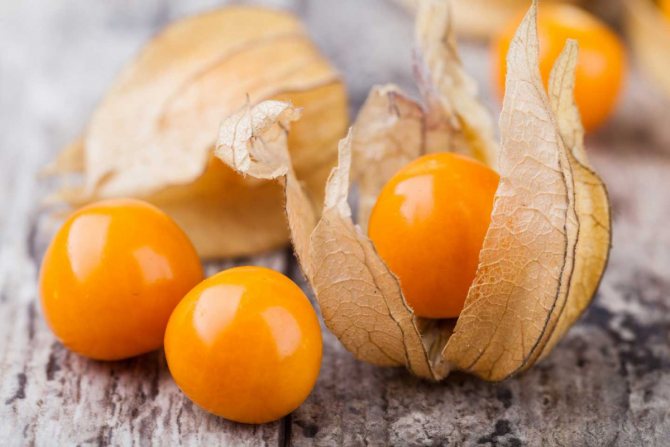

Watering must be carried out regularly and systematically. Despite the fact that strawberry physalis is resistant to extreme heat and drought, watering must be done regularly. So during the July heat, the plant should be watered less than 2 times a week, but in the presence of natural precipitation, it is worth reducing the procedure to 1 time.
Fertilization
Like any plant, strawberry physalis reacts favorably to feeding, especially since it must be carried out only three times during the entire growing season. The first time, when the plant begins to bloom, the second time - during the formation of fruits, and you need to finish the feeding procedure after 3 weeks, after the second time.
There are several variations of feeding, because each in its own way has a positive effect on plant growth and fruit formation. The simplest recipe is to combine two types of manure: cow and poultry manure, correctly observing the proportions, because the first one needs to be diluted 1:10, and the second - 1:15. The resulting mixture must be poured under each bush, on average, half a liter is enough.
The second method of feeding is supposed to be in the introduction of mineral fertilizers - a mixture of 10-15 grams of potassium salt and superphosphate, and 10 grams of ammonium nitrate, all contents are designed for 10 liters of water. After thoroughly mixing and dissolving the fertilizers, proceed to the pouring procedure, with the calculation of half a liter for each bush. Which way to choose, decide individually, but the best option would be to alternate these two dressings.
Those who want to pamper themselves with fresh sweet fruits of strawberry physalis all year round grow it on their windowsill. The care procedure is no different from growing in the open field, the main thing to remember is that this is a thermophilic plant and the sunny side will be the best place for growing strawberry physalis.
Juicy, bright orange and incredibly tasty fruits of strawberry physalis can be grown without much difficulty in your area, especially since, in addition to regular watering, several dressings, systematic loosening and hilling, no other care is required. Therefore, without a doubt, everyone can grow strawberry physalis on their site.
Strawberry Physalis is a relatively new and rare plant for Russian gardens, so it has few varieties. In the conditions of the middle lane, the variety Zolotaya Rossii (VNIISSOK selection) and the varieties Pineapple, Dessertny and Strawberry from the "Classic" series from agro have proven themselves well.
In my personal experience, no special fundamental differences between different varieties of strawberry physalis have been noticed. And the Mexican is a completely different plant.
Strawberry Physalis is a light-loving and heat-loving plant that does not withstand the slightest frost. In order for the berries to ripen in a short Central Russian summer, physalis must be grown through seedlings.
Seedling preparation
For seedlings, strawberry physalis is best sown in the second half of March. Any ready-made soil mixture designed for growing seedlings of solanaceous crops is suitable. Seeds are sown in pots with soil to a depth of 1 centimeter, placed on a warm and light windowsill and keep the soil constantly moderately moist. Seedlings appear about a week after sowing.
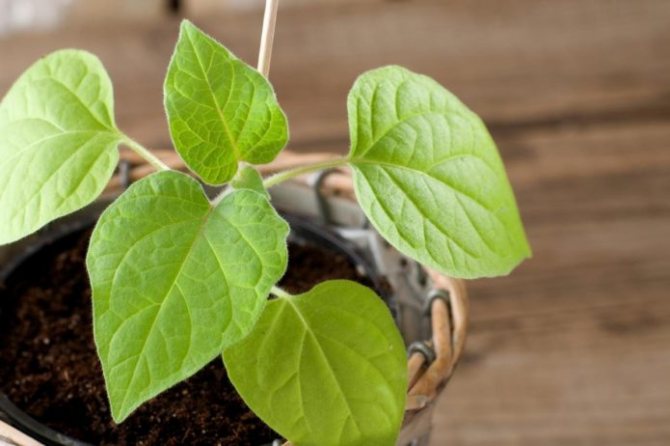

Physalis is safer to grow through seedlings
In my opinion, the easiest way is to sow 2-3 seeds in a yoghurt cup, and then leave 1 of the most powerful plants that have emerged, carefully pinching the remaining unnecessary ones under the root.
Physalis can be planted in open ground only after the end of spring frosts, without shelter it is not earlier than the beginning of June, and under the film it can be planted already at the end of May. It is necessary to plant on a well-lit garden bed with fertile soil, placing an earthen clod at the same depth as the seedlings grew in pots, and leaving at least 30 centimeters between the plants. Planted plants should be watered abundantly with water from a watering can.
Fruit ripening process
The fruits of strawberry physalis ripen not at the same time, but gradually, therefore, the harvest is stretched for a long period. If the fruits have crumbled, they can be consumed without any problems, since they are fully ripe. It is believed that Physalis will give birth until the very frost, but if you did not have time to harvest the maximum, do not despair, since the plucked fruits will ripen without any problems in a warm place indoors.
Strawberry physalis berries are in a greenish sheath, which bursts when ripe, revealing yellow-orange fruits the size of large cherries. They ripen gradually, they can be harvested before the first frost. But if unripe berries are left on the bushes, they can (like tomatoes) be successfully ripened in a warm and dry room.
I will not say that this physalis variety tastes much like strawberries. But still it is very pleasant, and adds an interesting spicy touch to any salads. Even if they contain sour tomatoes, physalis "corrects" this unwanted taste with its sweetness.
Harvesting, as a rule, is possible 2 months after planting the physalis on the site. By this time they are already ripe. This should only be done in dry weather. Suitable for food or processing and those that have fallen to the ground. It is only necessary to inspect and discard fruits that are clearly rotten.
- The stems of vegetable and berry crops, like all tomatoes, are disposed of after harvest, and the soil is dug up.
- The decorative physalis remains in the ground for the winter, but is completely cut off to ground level. From twigs with fruits, bouquets are formed, which are used to decorate the home.
Composition and properties
All the benefits provided to the body by this plant are explained by the rich composition:
- minerals (magnesium, iron, potassium, zinc);
- cellulose;
- fixed oils;
- proteins;
- organic acids (malic, tartaric, etc.);
- sugar;
- carbohydrates;
- tannins;
- vitamins C and A;
- alkaloids, flavonoids.
Due to its composition, the benefits of physalis are undeniable, and it occupies one of the places of honor among other medicinal plants in folk recipes. In the role of an auxiliary agent, healing physalis can be used to treat the genitourinary system, joints, respiratory system, hepatitis, gonorrhea, dysentery, as well as for the prevention of cancer.
But not everyone is allowed to use this plant, there are contraindications for physalis.
The case for an unusual vegetable
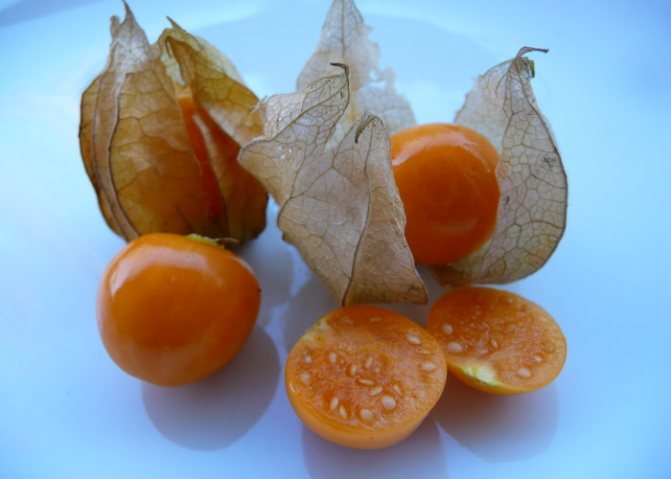

Look carefully in specialized stores or websites for the necessary physalis seeds. You can buy varieties that taste extraordinary. It is simply impossible to compare a culture with any other. The aroma and aftertaste of the vegetable is so unique that only an independent test can describe all the sensations. Dishes that can be prepared from culture are often served in fine dining restaurants. The cost of a kilogram of fruit bites heavily compared to ordinary members of the nightshade family.
But for those who persist in pursuing their goal, nothing is impossible. Growing and caring for physalis is not at all difficult. He is not a capricious and gentle culture. So what can prevent a person who works a lot and with pleasure on the earth from growing another type of healthy and tasty plant? Moreover, it is absolutely unpretentious ...
A little effort, the care that all other plants require no less, but on the contrary, sometimes more, and unusual plants with original lanterns will turn green in the garden beds.Varieties that are grown specifically for eating fruits will bring a lot of pleasure to gourmets and ordinary people. Ornamental plant species will allow you to create charming compositions with bright lanterns rustling with every touch. The popularity of this representative of the nightshade family is growing every year. Having figured out the simple intricacies of growing a vegetable. Gardeners are happy to find the time and energy to get an original harvest from small, but healthy and tasty fruits. Preservation, marinades from physalis and just eating it fresh are very popular with people who are familiar with this plant. And those who have not yet tasted this unforgettable delicacy need to urgently take some measures!
Reproduction methods
Seeds
Seeds propagate annual forms - vegetable and berry varieties. After germination, the seedlings dive, grow in room conditions or in heated greenhouses. They are planted in the ground with steady warming.
Layers
The method of propagation of decorative physalis by layering is simple and effective. To do this, in the spring, a part of the rhizome with new shoots is planted in a new place.
Cuttings
Cuttings are made as mentioned above.
Disease prevention
Shoots on which disease symptoms appear are removed. Treating seeds can help reduce the risk of developing the disease, as well as:
- compliance with crop rotation and crop care rules;
- correct collection of seed material (only from healthy plants!);
- constant control of pests and diseases;
- thorough preparation of the soil, removal of plant residues, on which pathogens could remain.
The crop is harvested when ripe fruits begin to fall to the ground. Unripe physalis is laid out in a box and put away for ripening in a cool place. Pulp - a vegetable "cover" - should not be removed: the fruits will last longer.
How to harvest physalis seeds correctly
Ripe large fruits are taken for seeds and ripened for two weeks in a room at a temperature of 20-25 ° C. Then:
- The fruits are kneaded in a glass container.
- Withstand 3-5 days for fermentation.
- The top layer (pulp) is removed, and the seeds remaining at the bottom are washed several times with water and dried on paper.
Physalis seeds have a shelf life of 3-4 years in an opaque paper package in an airtight container placed in a cool dry place. Germination rate is 90-96%.
Useful properties and contraindications
Composition, nutritional value, calorie content
Any physalis fruit, vegetable or berry, contains a lot of vitamins and minerals. A huge amount of vitamin C, vitamin A (14% of the daily dose required for the body), antioxidants and a unique composition of B vitamins make the plant indispensable in medical nutrition. In addition, physalis fruits are low in calories, they can be used in diets for metabolic disorders accompanied by excess weight. Let us consider in more detail what benefits and harms this plant brings.
Beneficial features
To illustrate the beneficial properties of physalis, one can cite as an example the opinion of the famous folk healer Alexei.
- with stones in the kidneys and bladder - a decoction of the fruit inside;
- with gout and edema - decoction of the fruit externally;
- for purulent inflammations - juice or infusion. You can use fresh berries;
- for pain in the stomach and intestines - fresh fruit puree;
- for dermatitis - physalis ointment (fruit ash mixed with vegetable oils).
Contraindications
There are no special contraindications to the use of physalis. However, it must be remembered that, like any sour fruit, it can aggravate patients with gastritis. It is also necessary to exercise caution in patients with pancreatic and gallbladder insufficiency. Very sweet varieties should limit diabetics in their menu.
Application area
As mentioned above, the scope of application is quite wide.You can use decoctions for influenza, laryngitis, lung diseases. Low-calorie desserts are good for dieters.
Traditional medicine recipes
Decoction
Place 30 g of dried fruits in 0.5 l of water and cook for five minutes. Apply the resulting dose within two days for kidney and bladder diseases.
Ointment
The dried fruits (100 g) are burned in an open flame until ash is obtained. Grind and sift the ashes. Mix with a little olive oil until you get the consistency of an ointment. Use for healing wounds, cracks and dermatitis.
Physalis in cooking
The ripe fruits of the plant with a piquant bitterness are a dietary product that they began not only to add to vegetable salads with pleasure, but also to harvest for the winter, and also to use as a seasoning.
Physalis berries can be pickled, cook caviar from them, salt, cook jam, jam, etc. The range of application of these fruits is already quite wide, thanks to which the recipes for preparing physalis for the winter are constantly being added. People try to cook it in different ways, experimenting and creating their own versions of new dishes.
Winter preparations for the winter with physalis are snacks and sweets that are unusual in taste, and their shelf life in some recipes can last for years.
What can be prepared for the winter
There are many recipes for physalis blanks for every taste, and each resulting dish is useful and original in its own way, and it is even interesting to cook using such an unusual product.
Physalis pickled (in cans)
To prepare such an original snack you will need:
- vegetable physalis;
- granulated sugar;
- water;
- vinegar (table);
- some garlic;
- spices (currant leaves, celery, parsley - twigs).
Physalis recipes
Salty
For 1 kg of workpiece:
- Fruits - 1 kg;
- Dill - 50 g;
- Horseradish root - to taste;
- Garlic - 2 cloves;
- Hot pepper to taste;
- Salt - 50-60 g;
- Currant leaf - 5-7 pcs.;
- Tarragon - several branches;
- Cilantro - 7-10 seeds;
- Water - 1 liter.
Peel the fruits, rinse, place in sterilized jars. Prepare the brine - boil all the spices and salt in a liter of water. Pour everything with brine, place the grated garlic there. Leave the jars in a warm place for a week. Check fermentation progress daily. When the brine turns sour, drain it and boil it several times. Pour the contents of the jars with boiling brine, roll up, wrap. Store in a cool place.
Caviar
- Physalis fruits - 1 kg;
- Onions - 500 g;
- Carrots - 500 g;
- Parsley root - 200-300 g;
- Salt to taste;
- Sugar to taste;
- Garlic - 3 cloves;
- Ground black pepper -1/2 teaspoon.
Prepare all vegetables and fry in vegetable oil. Put everything in a container, add the rest of the ingredients, simmer. Grind with a blender, cool. Serve with meat or poultry.
Physalis, a wonderful plant, is not widely distributed, and completely undeserved. But every lover of beauty, if he dares to plant a wonderful "bubble" of physalis, will certainly be rewarded for the work on its cultivation with the gorgeous glow of Chinese lanterns on cloudy autumn days, the wonderful aroma of exotic jam and spicy pickles that stimulate the appetite.

